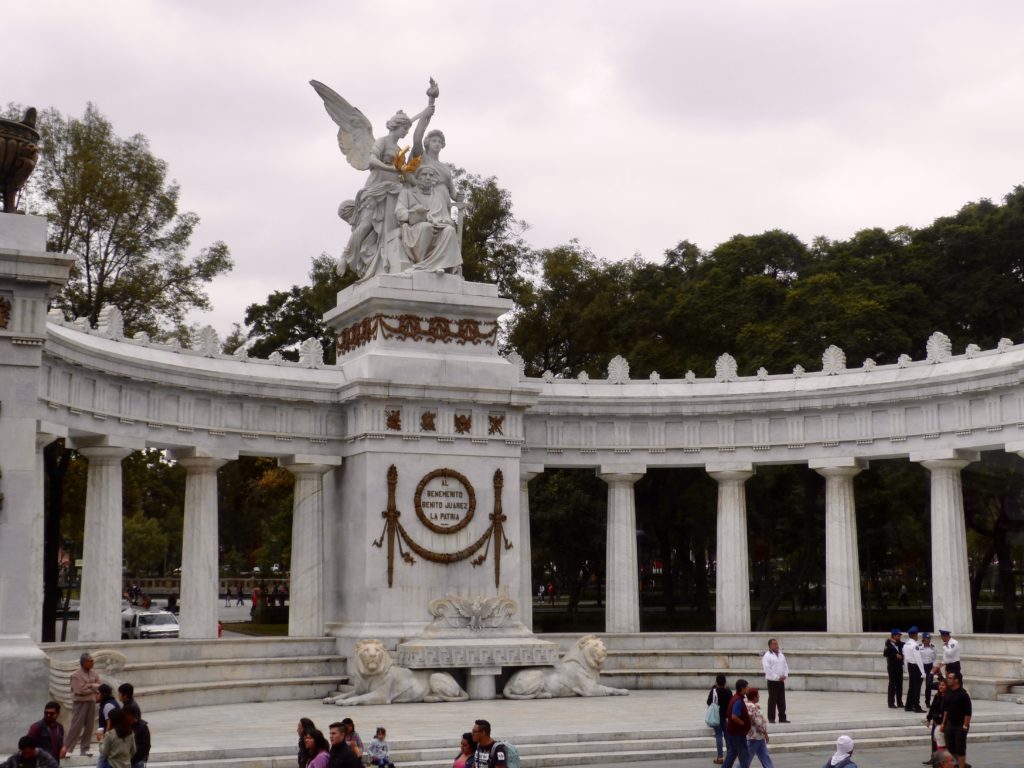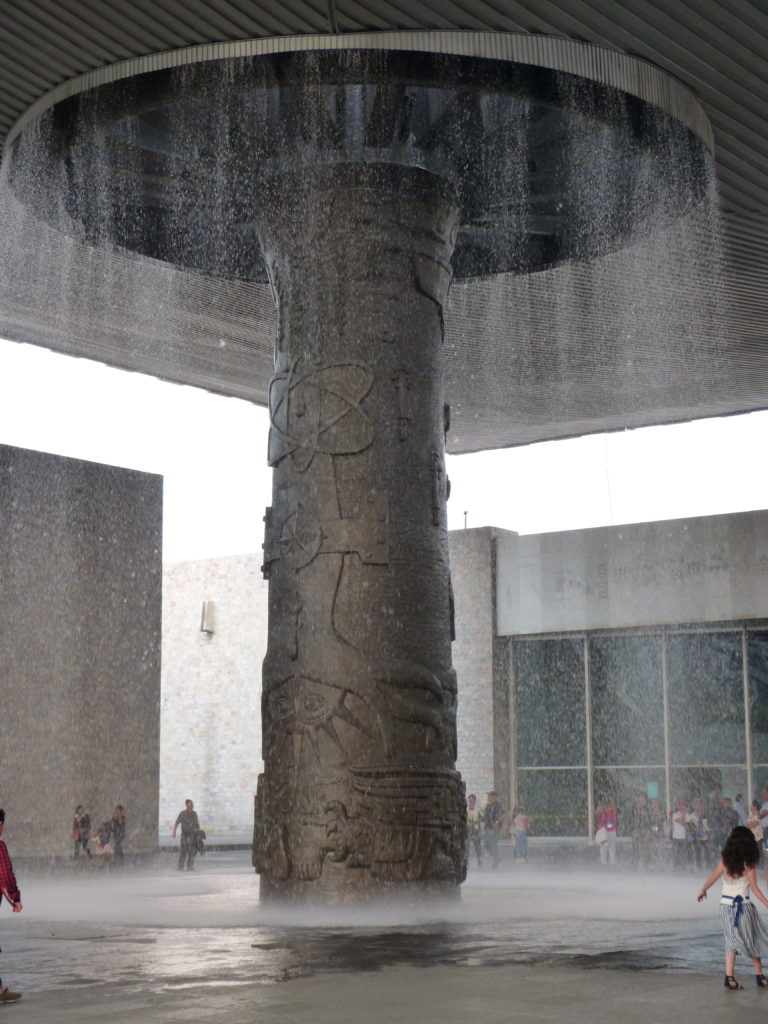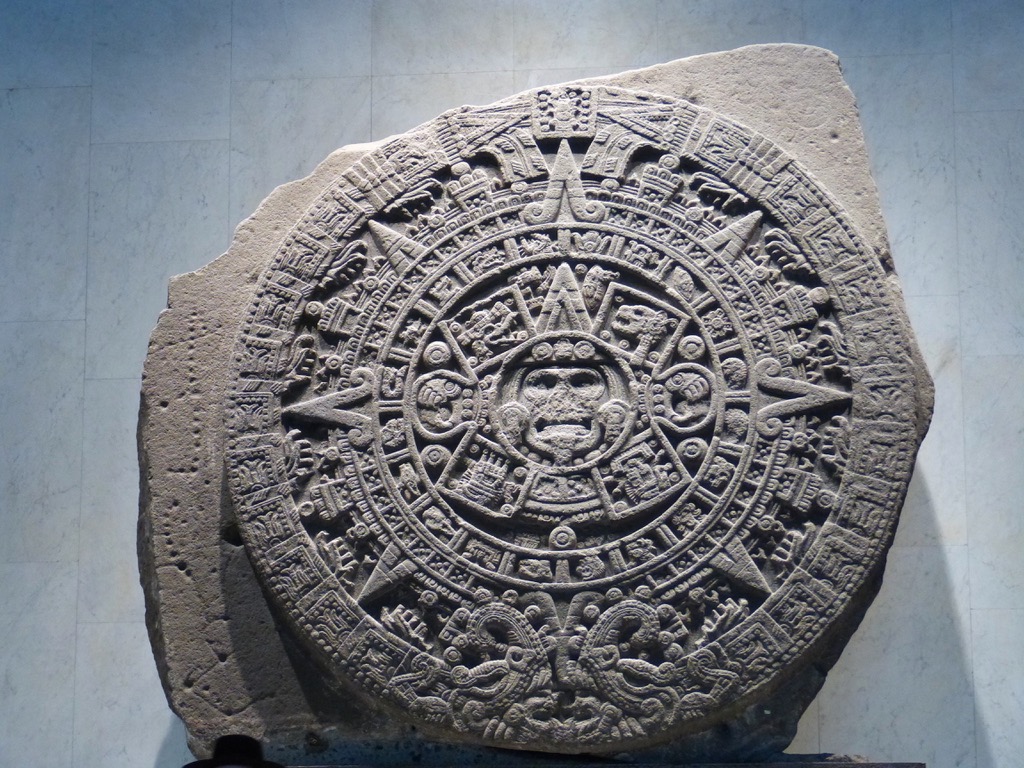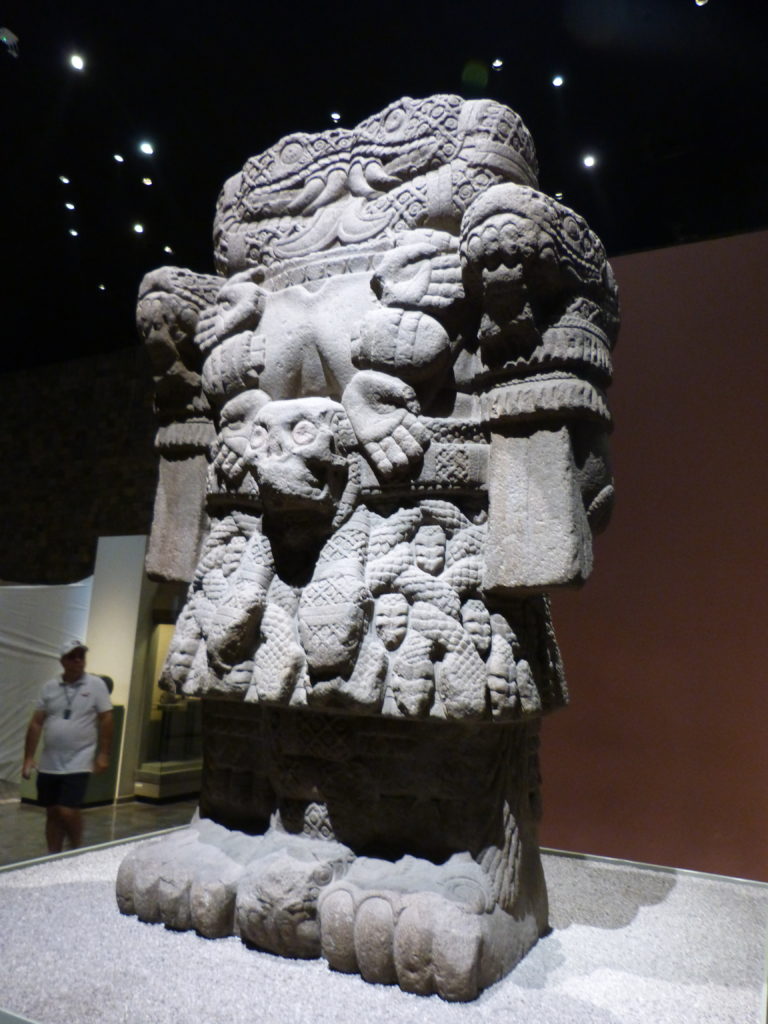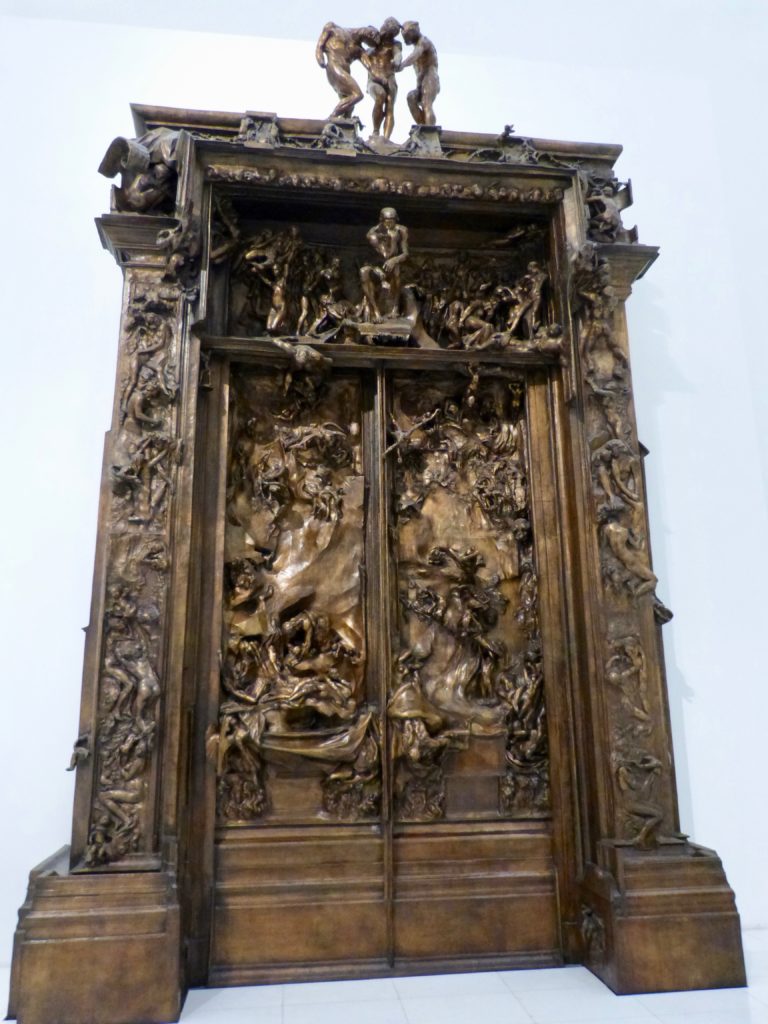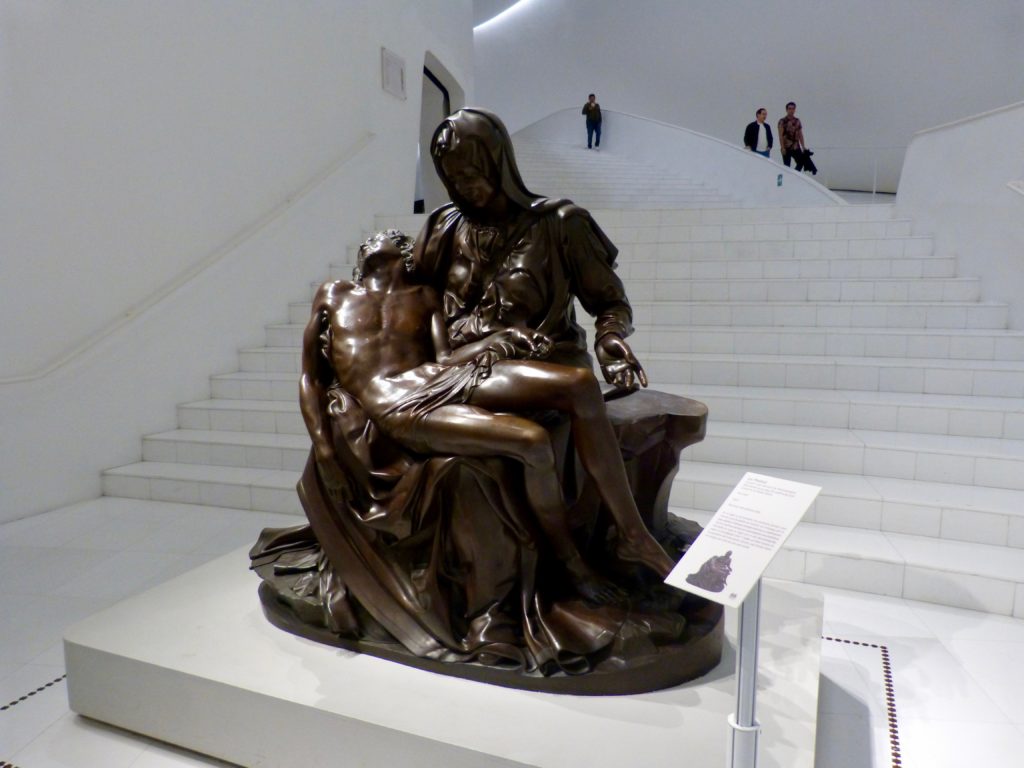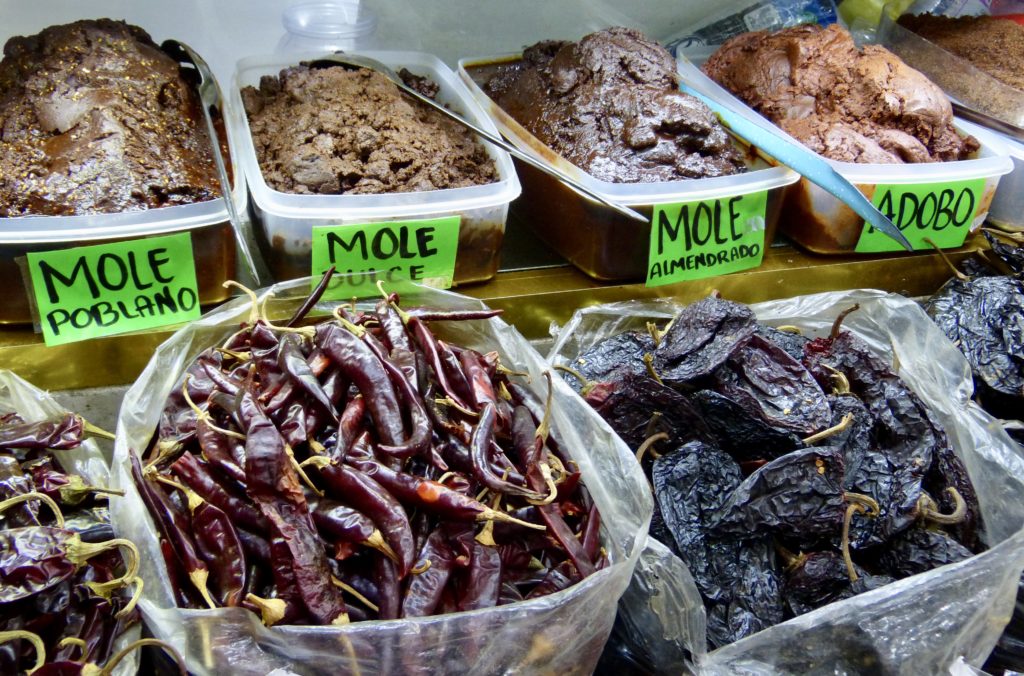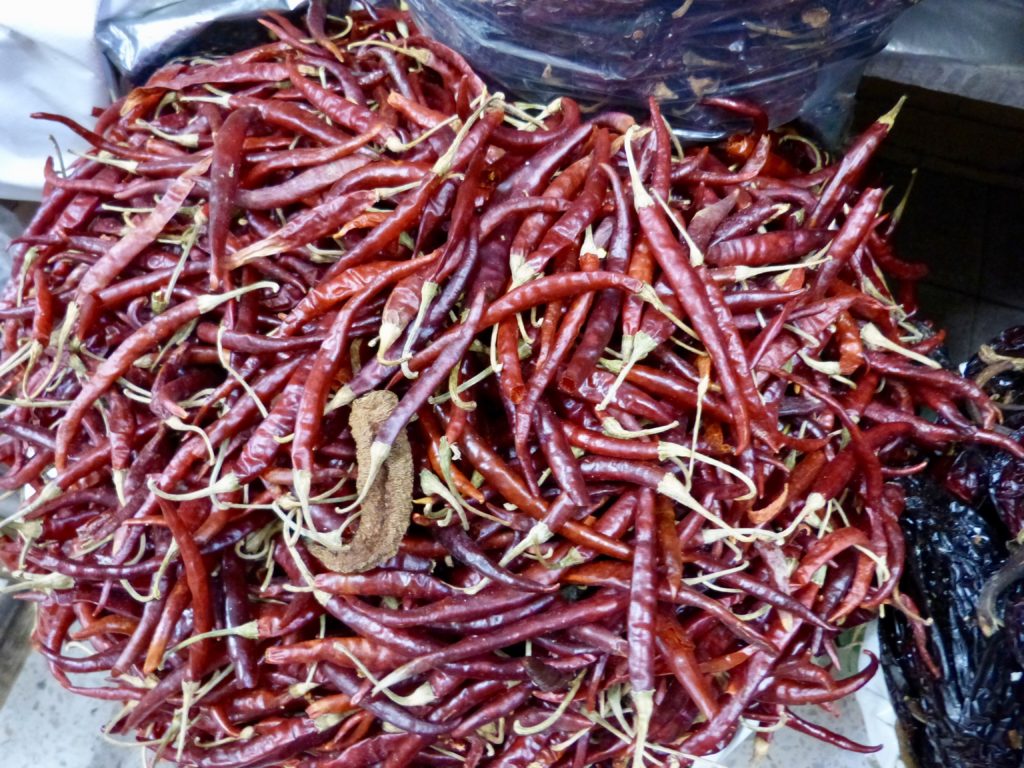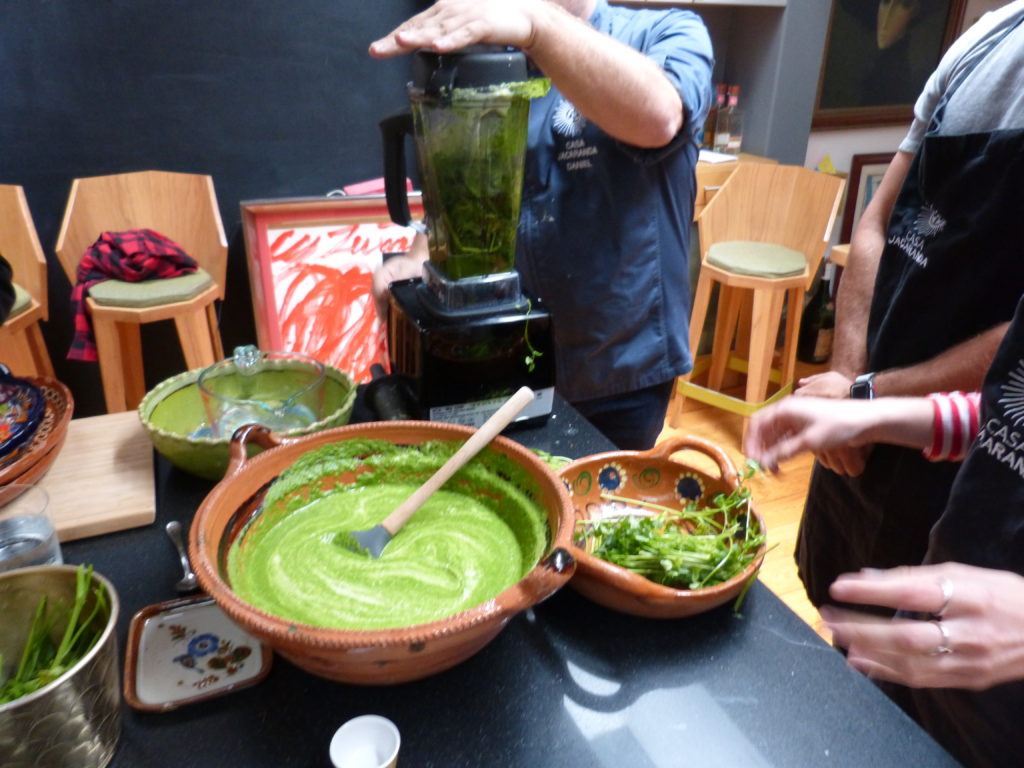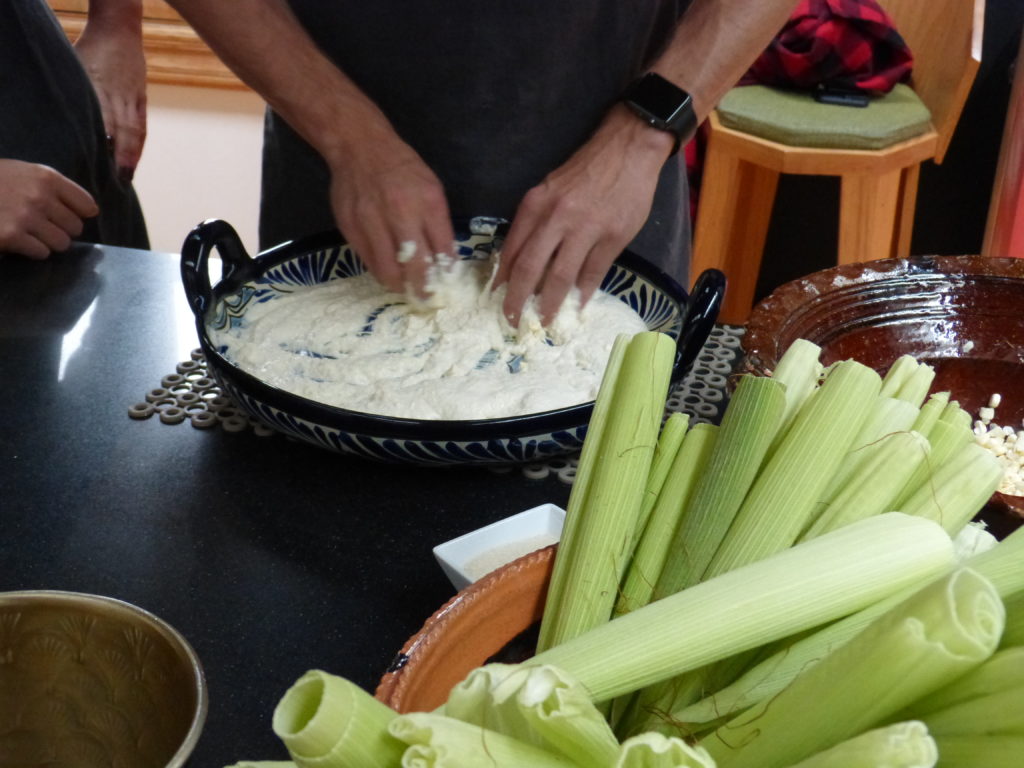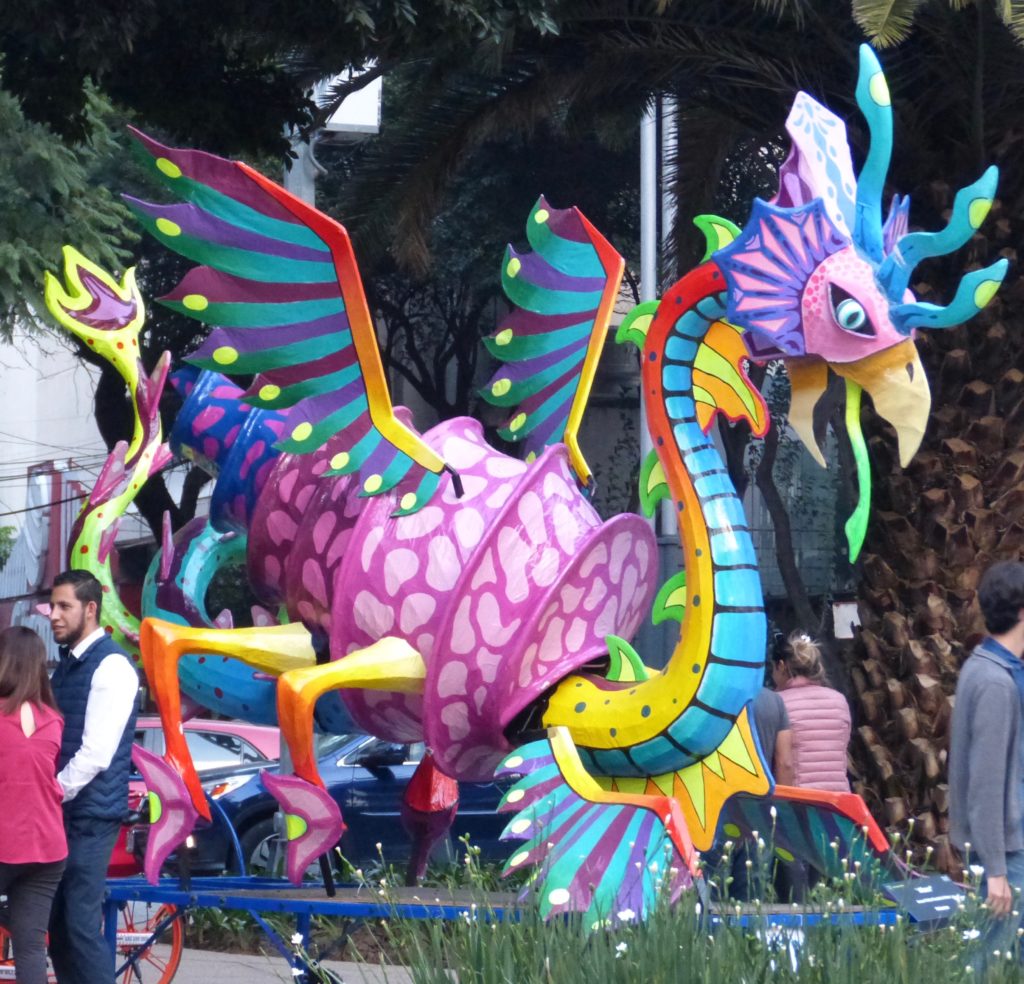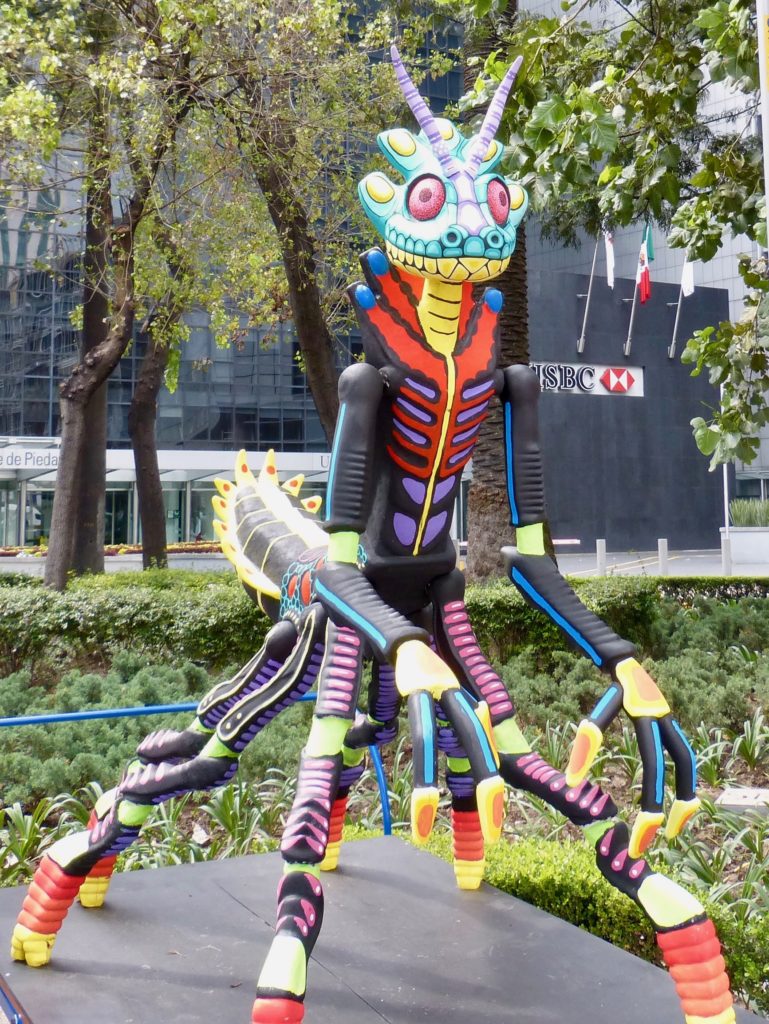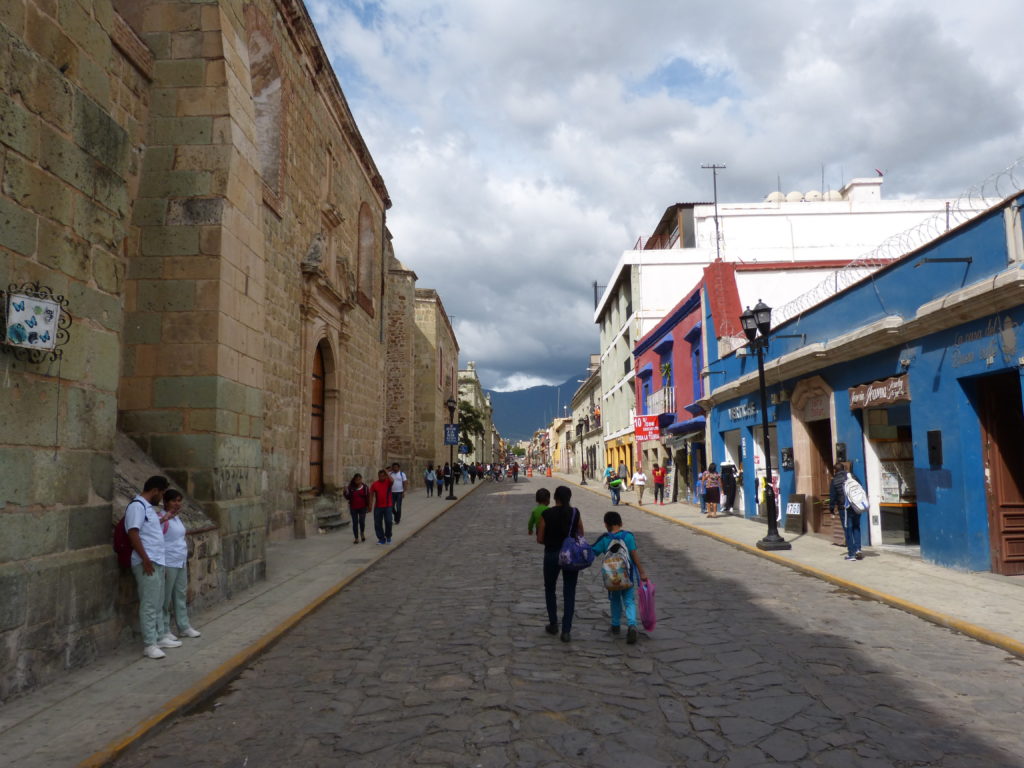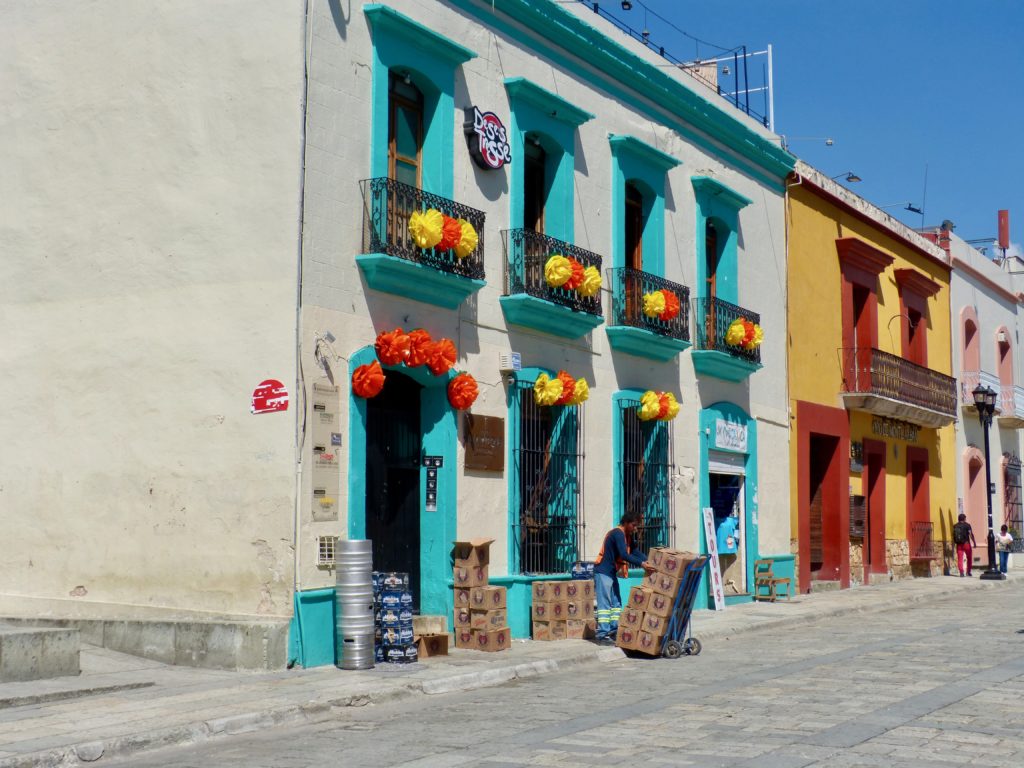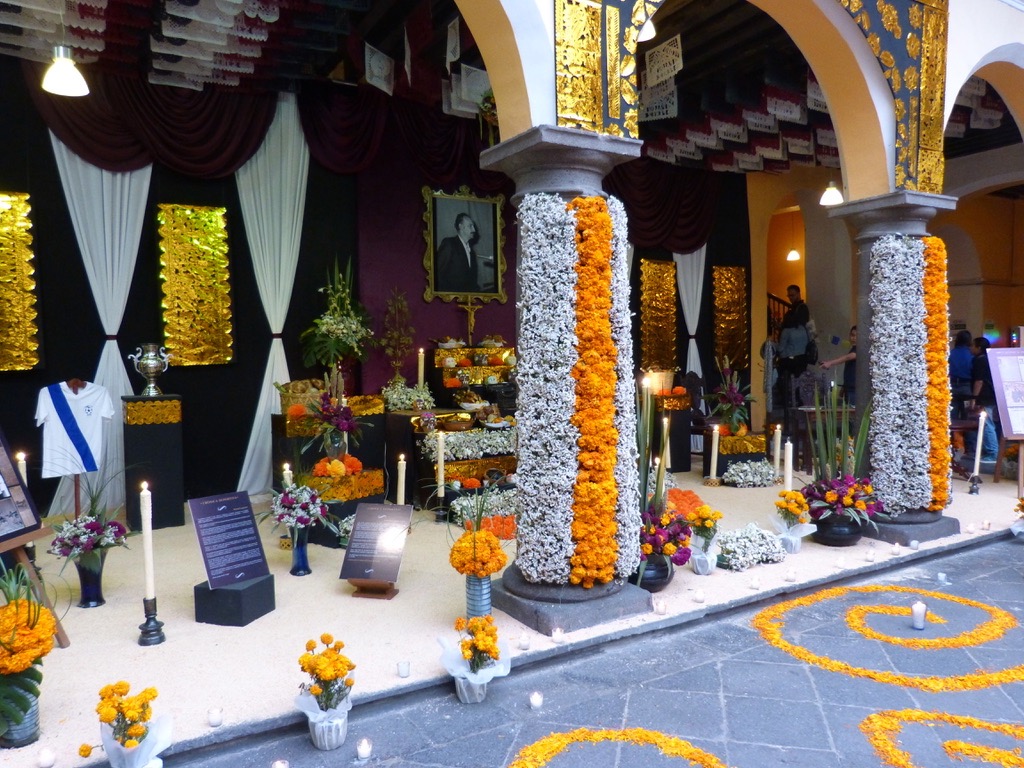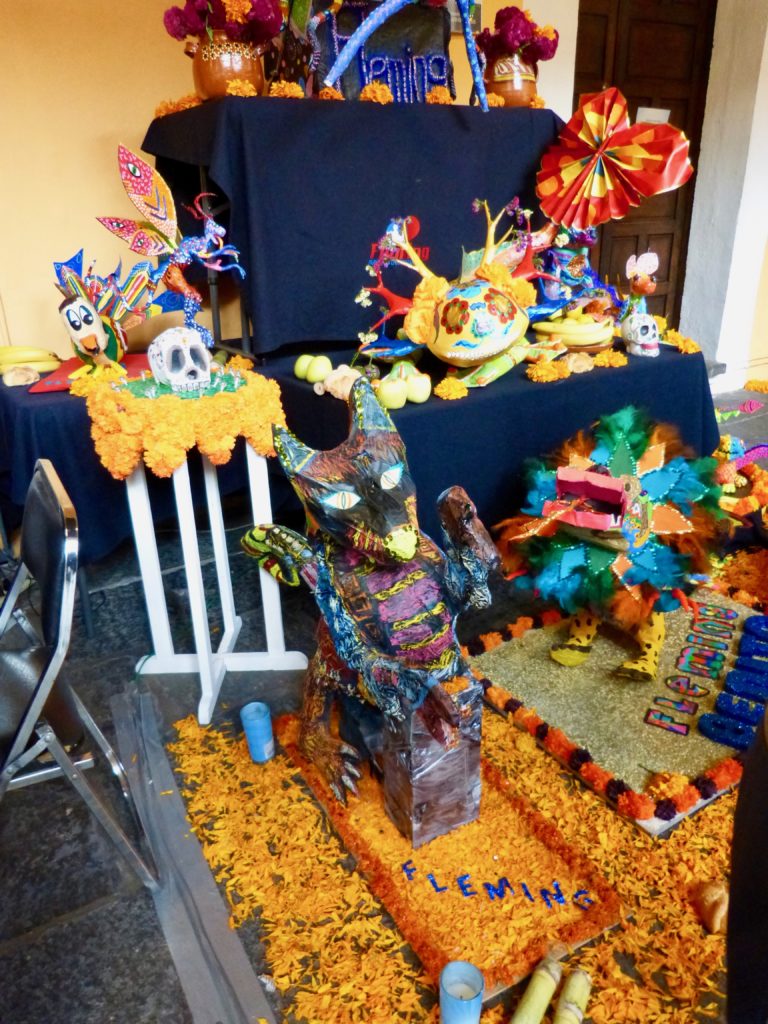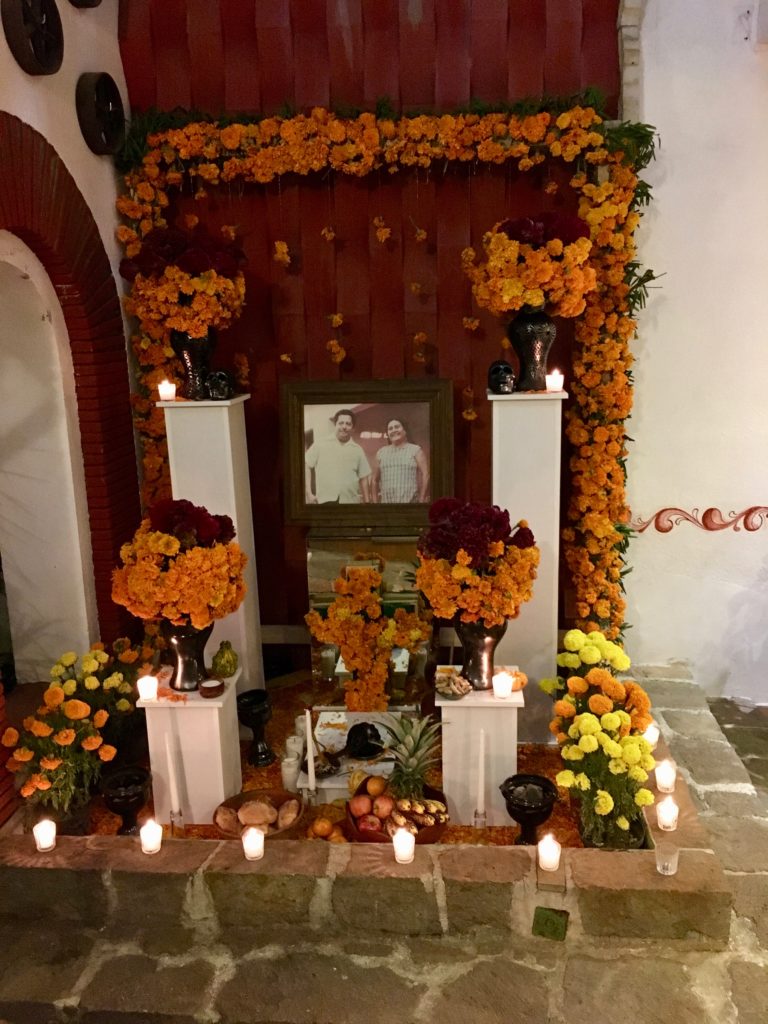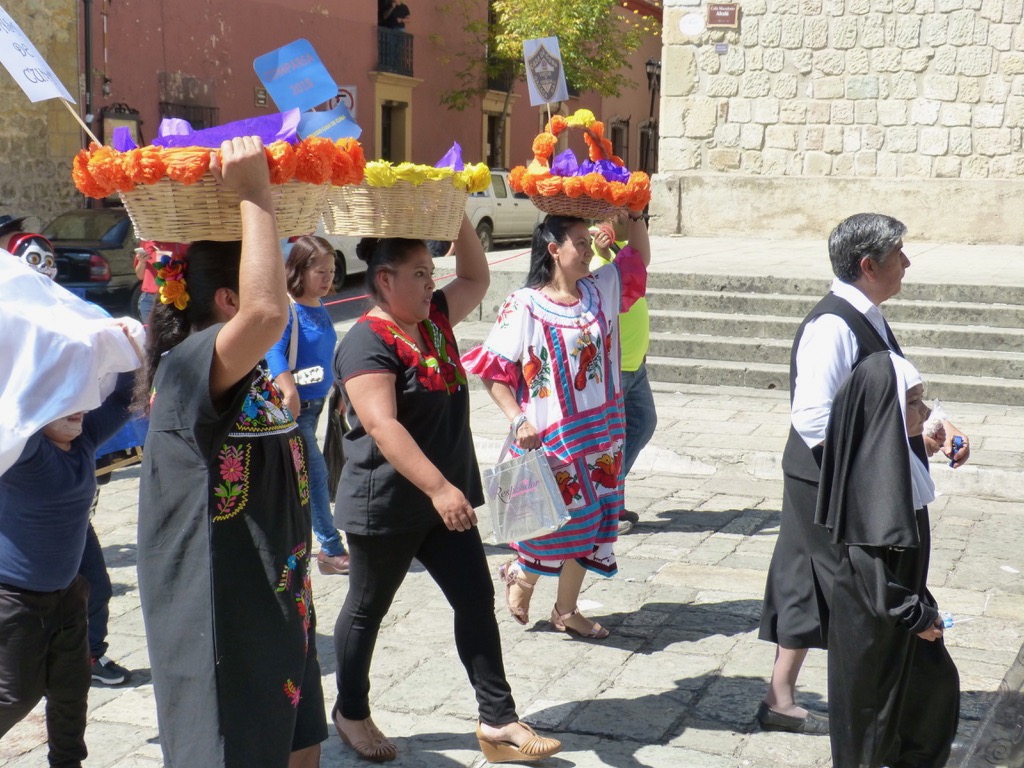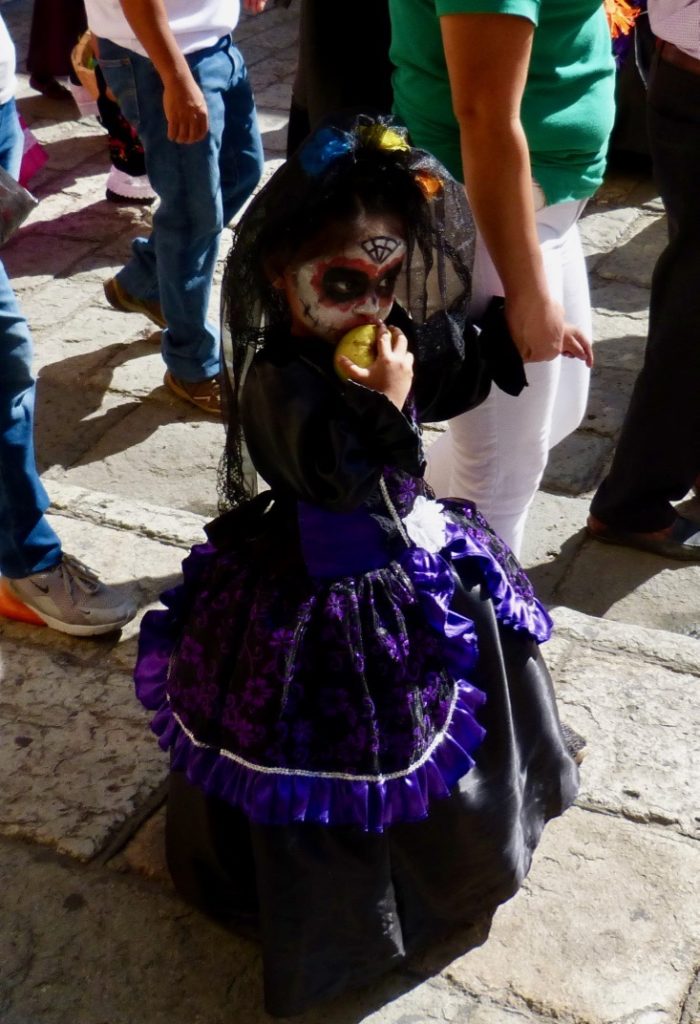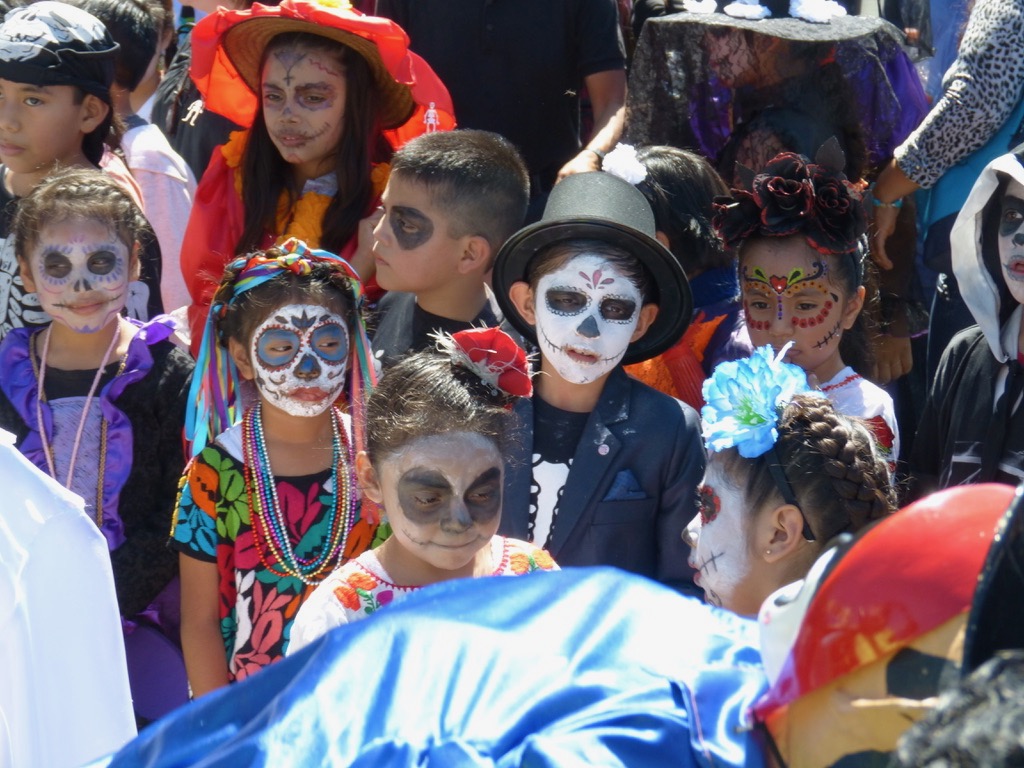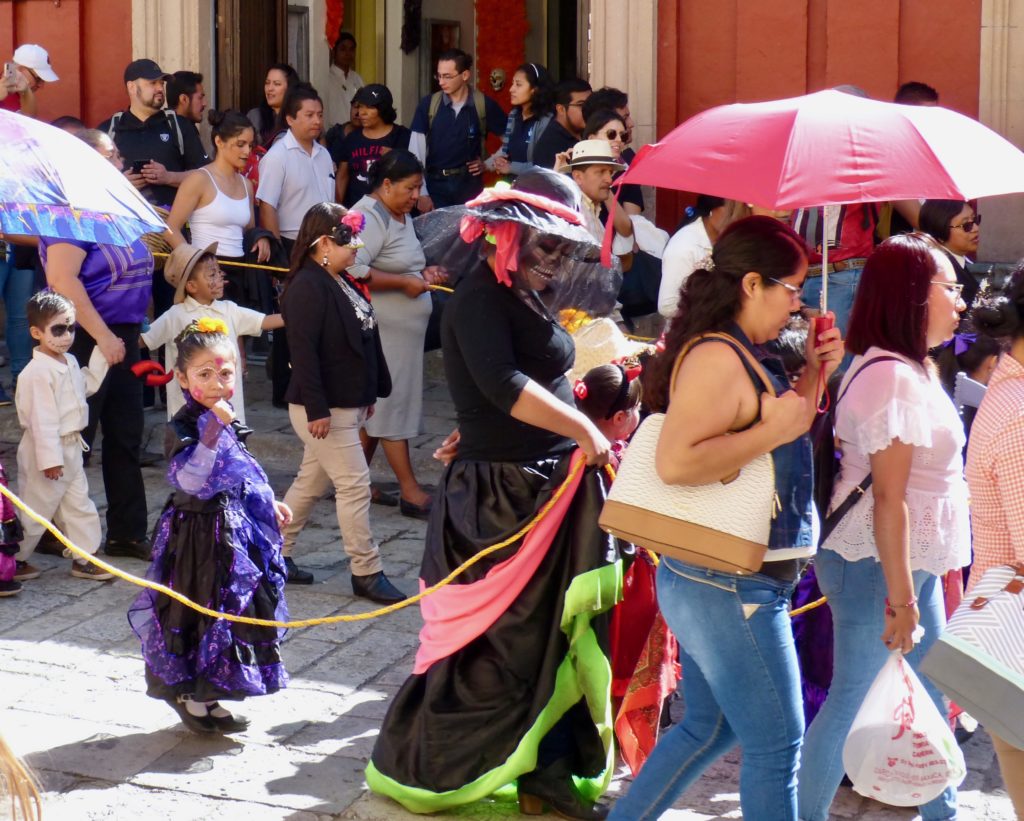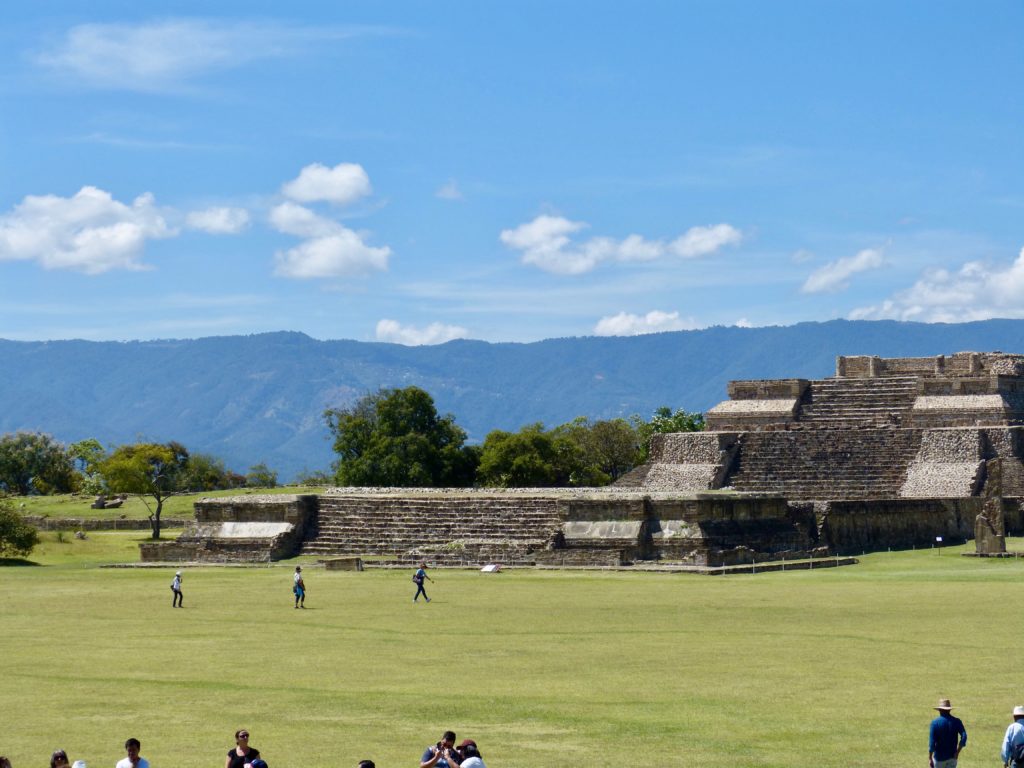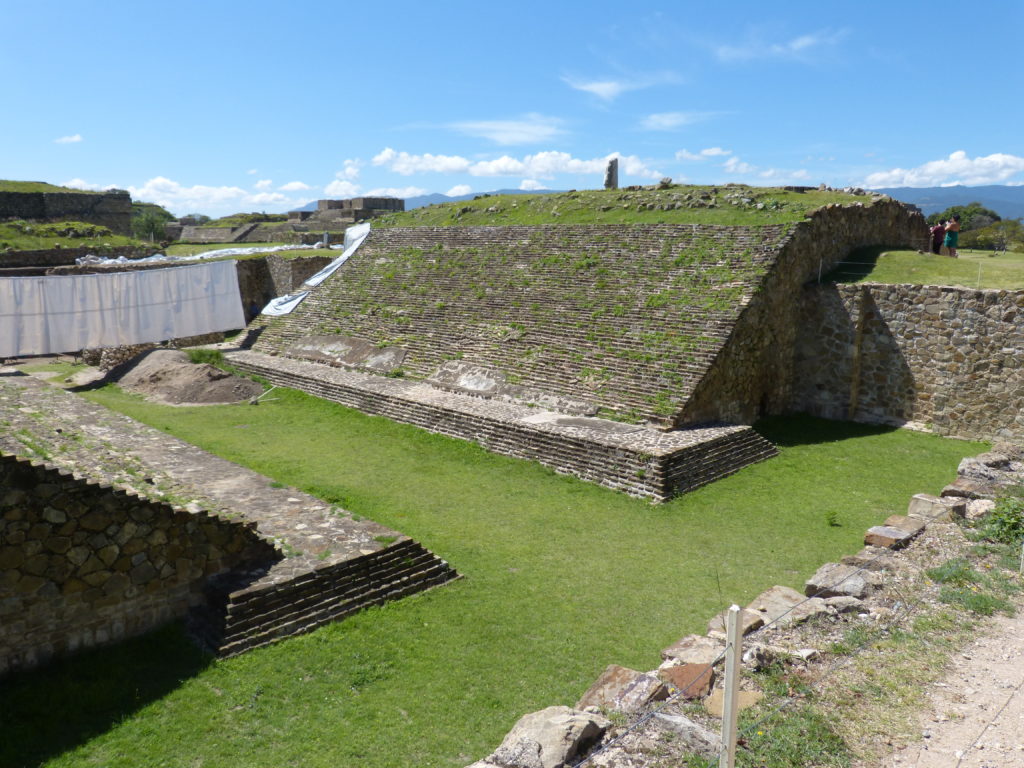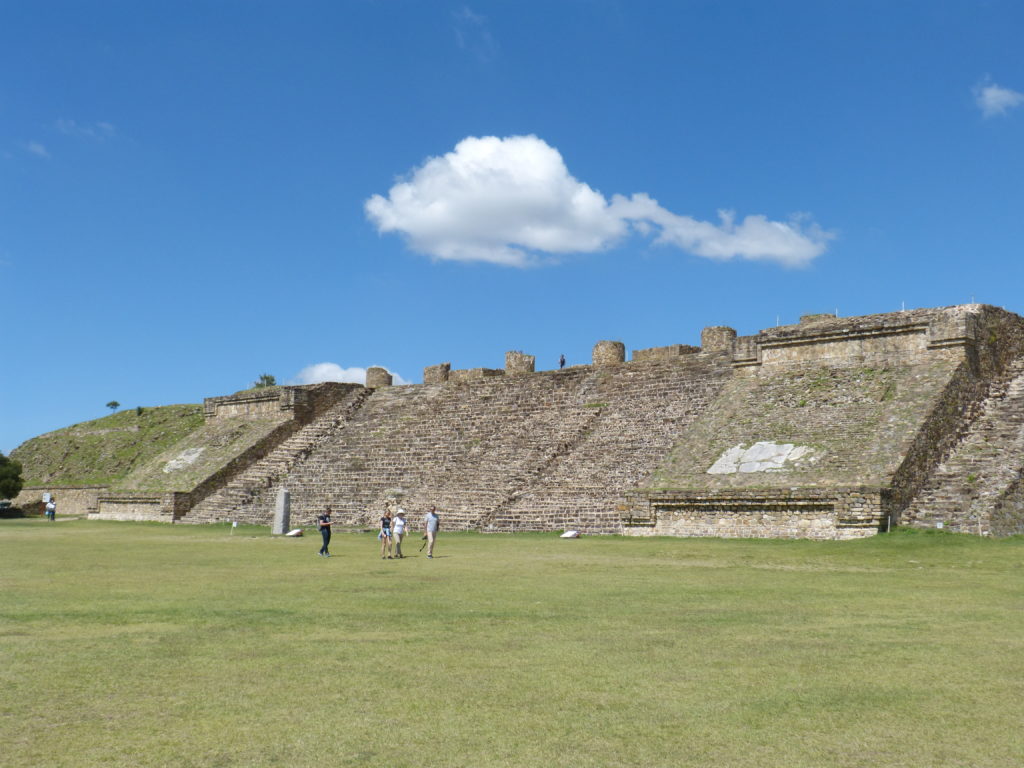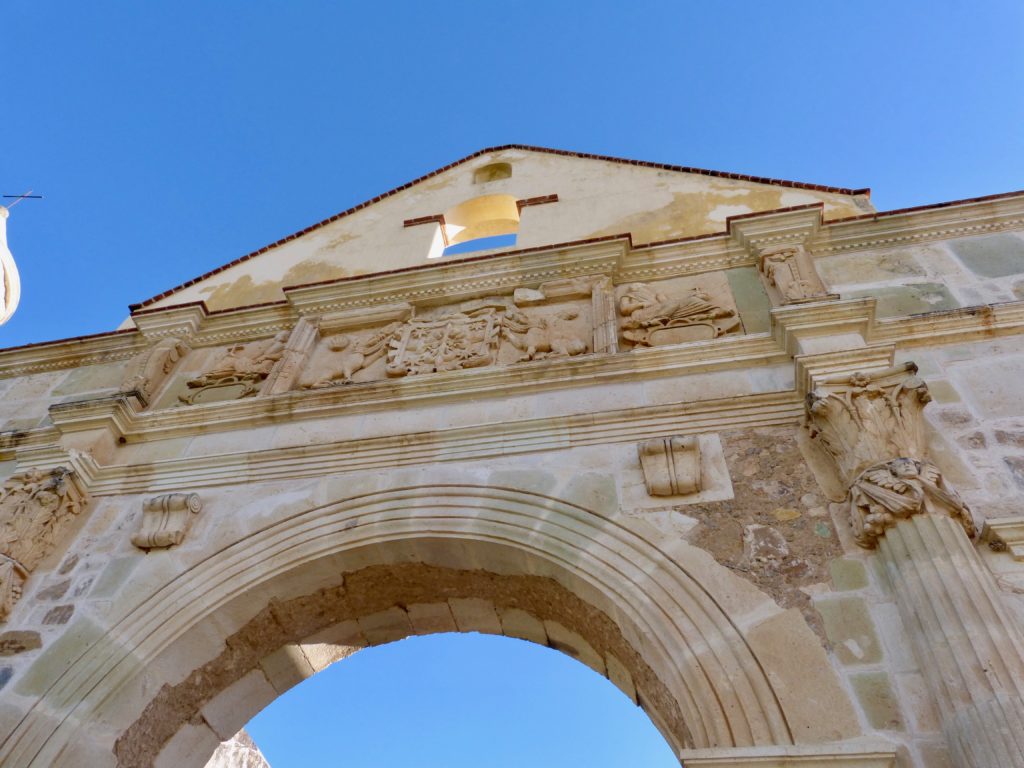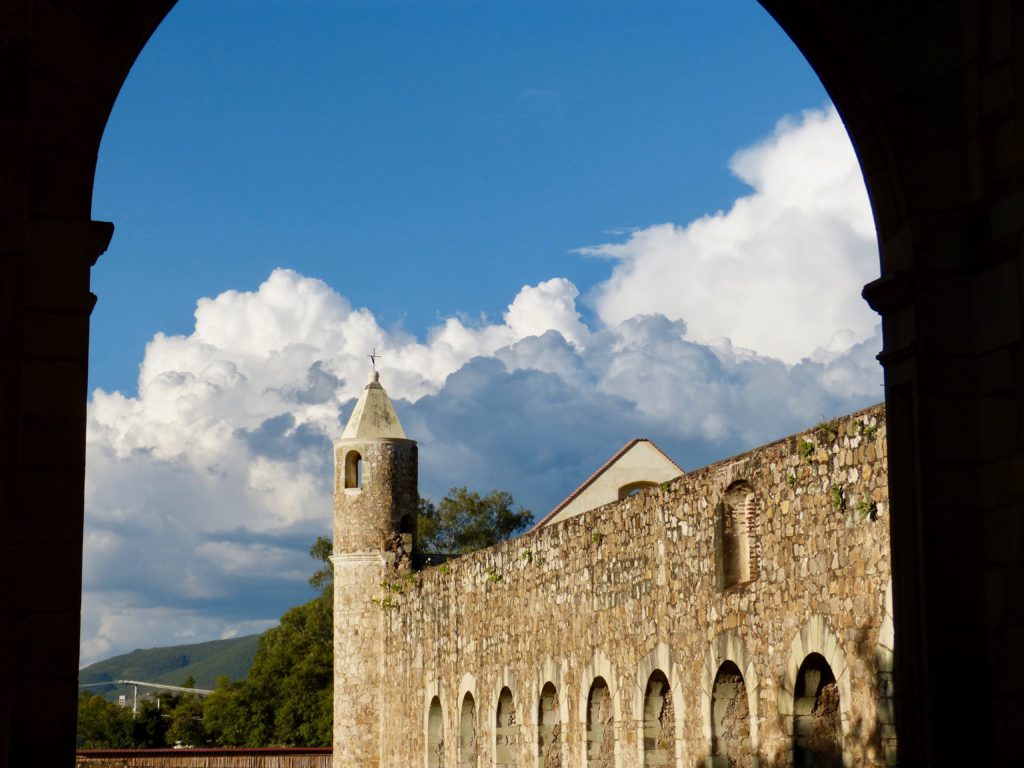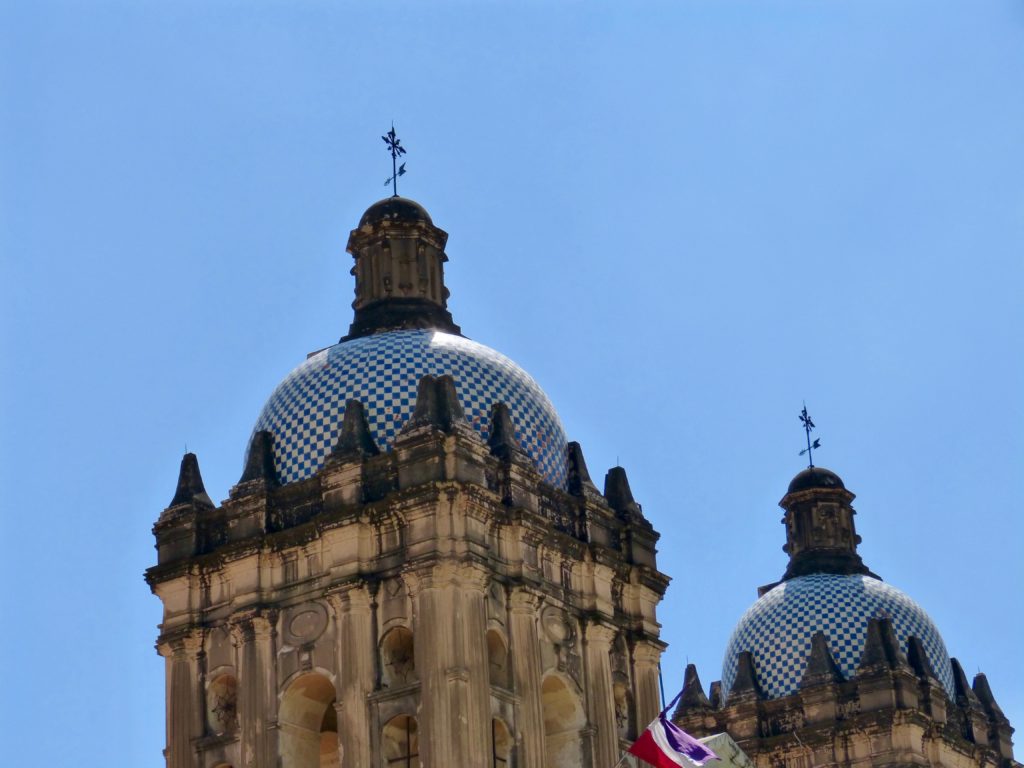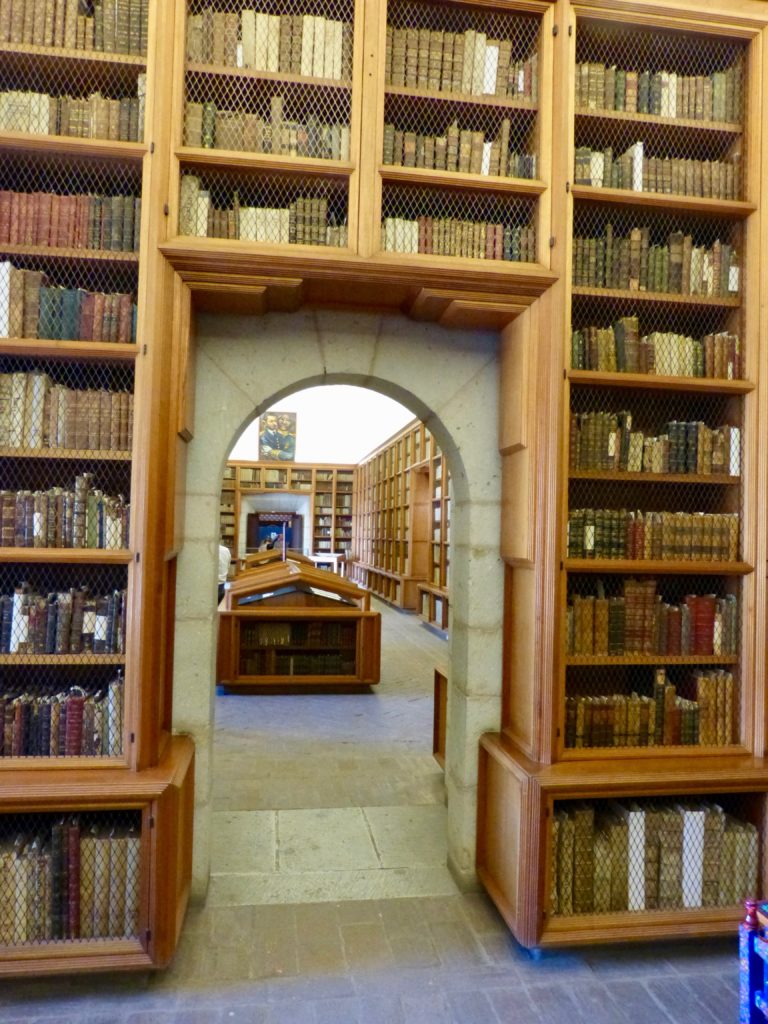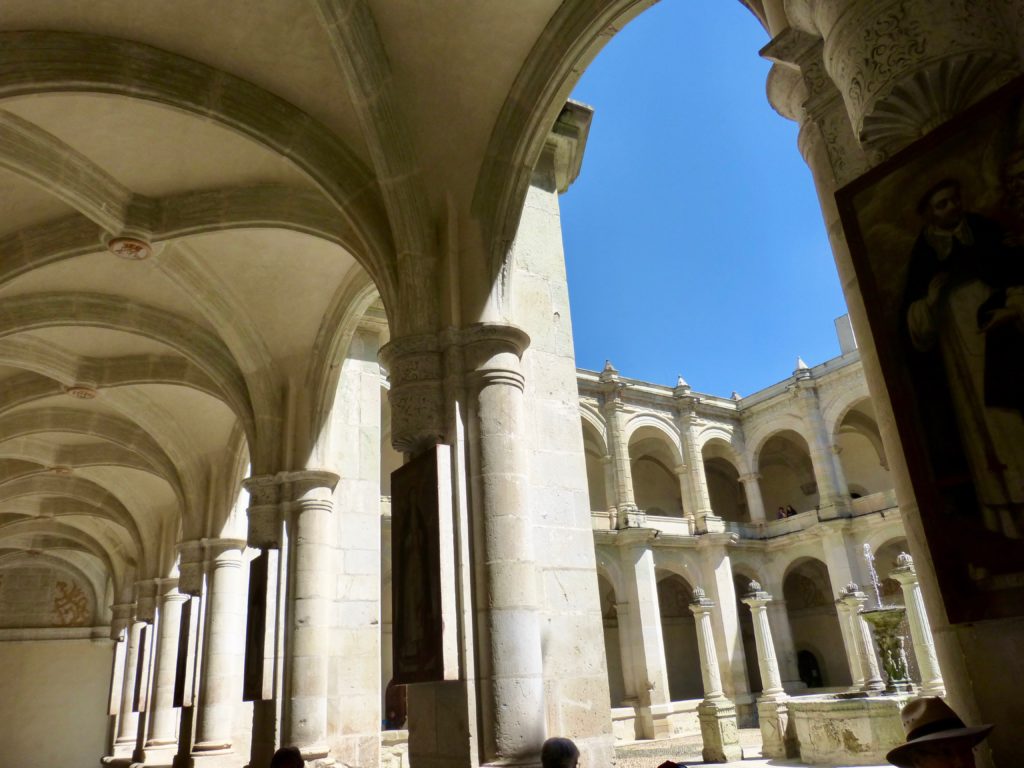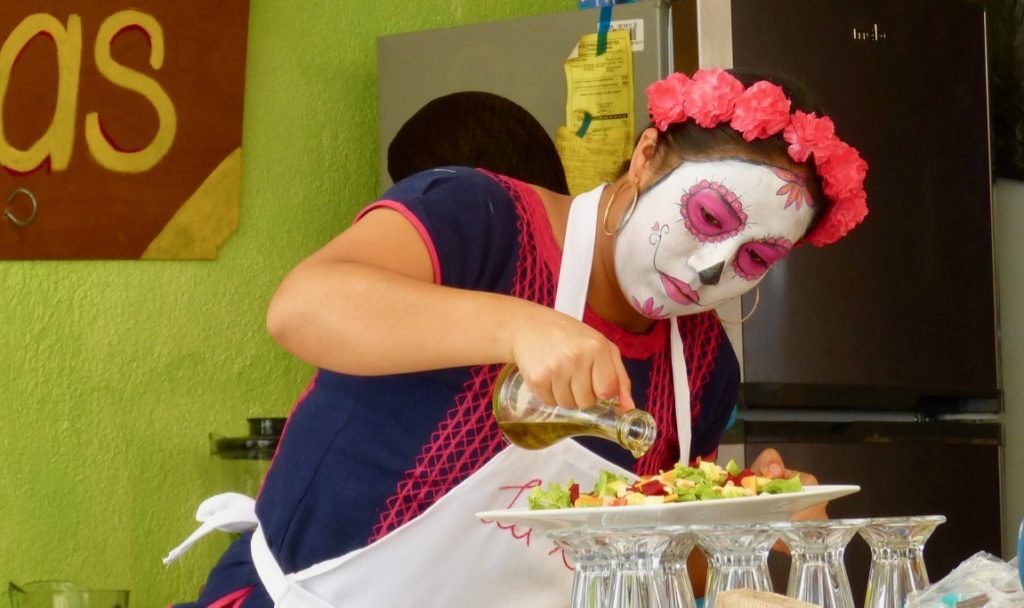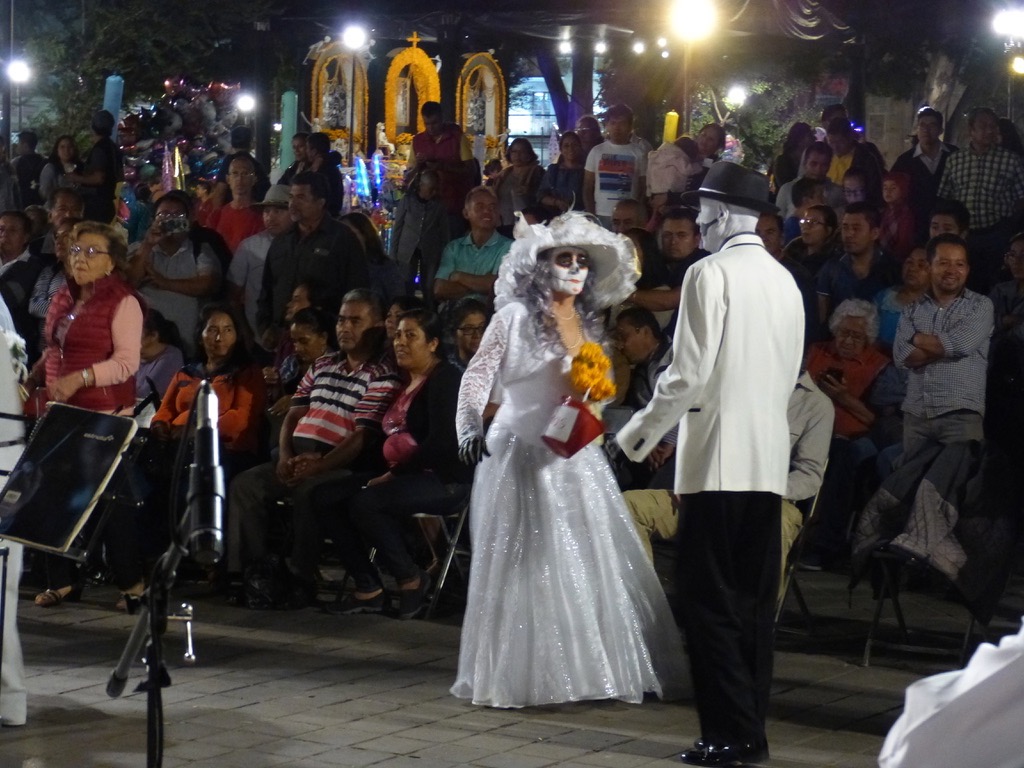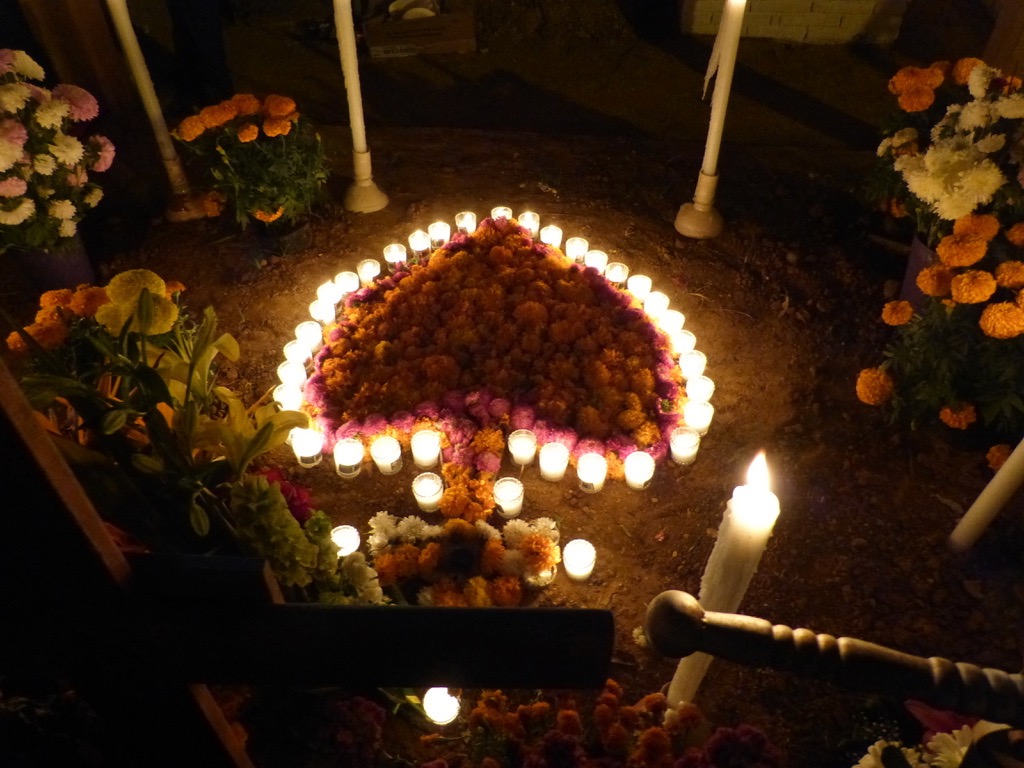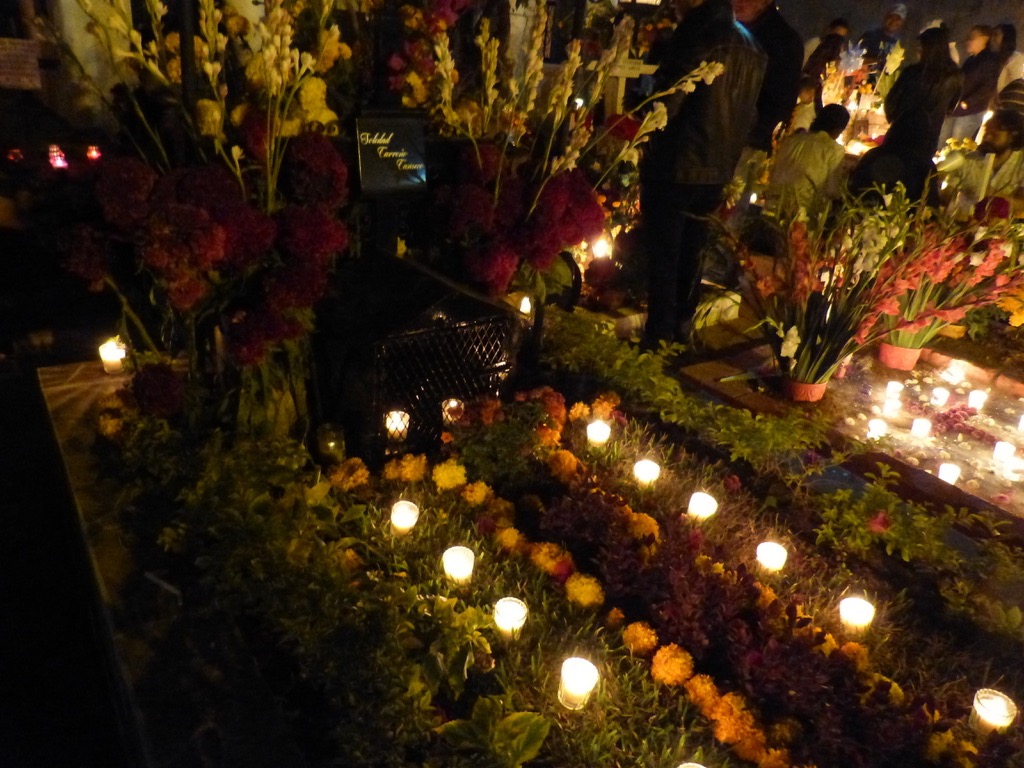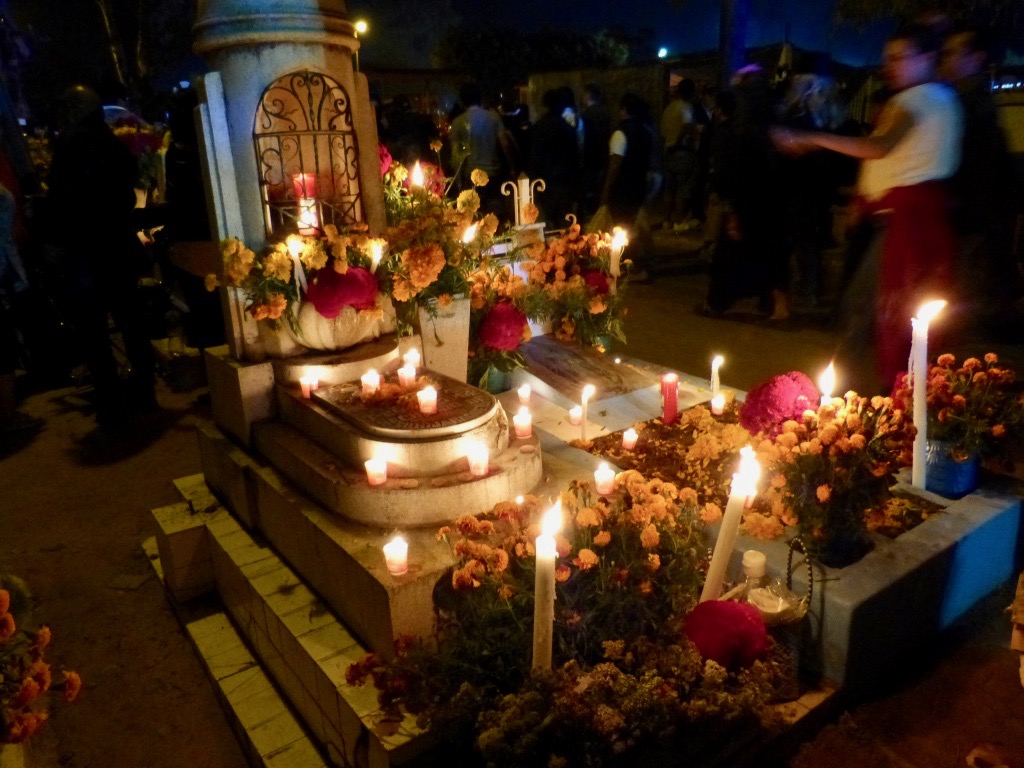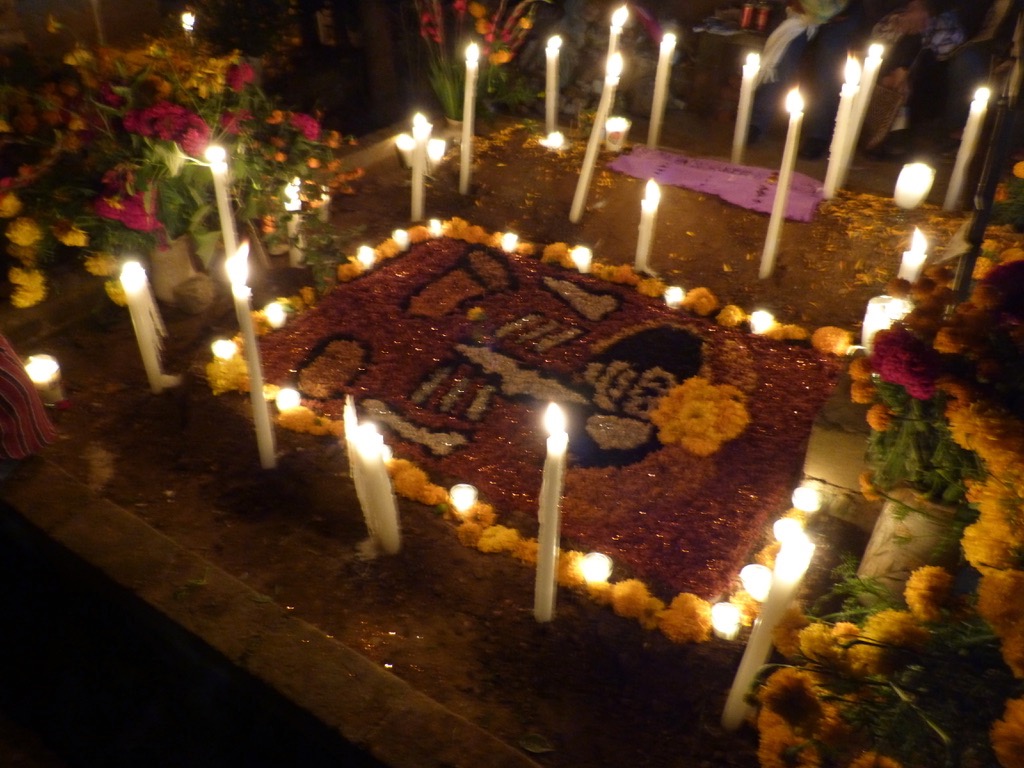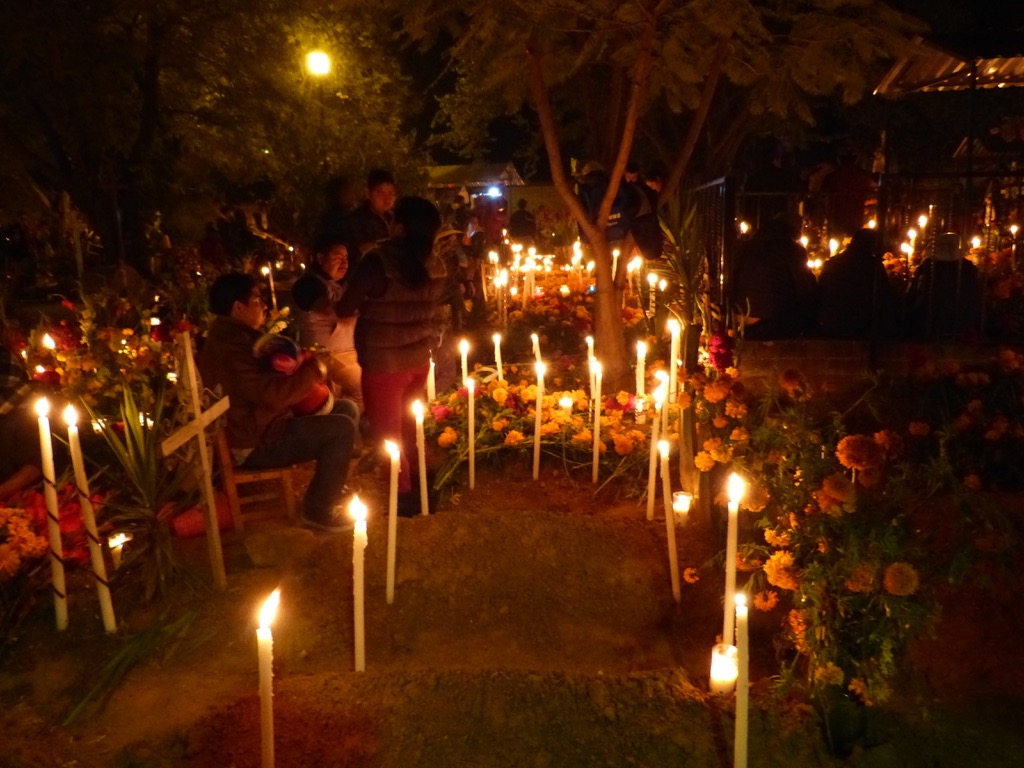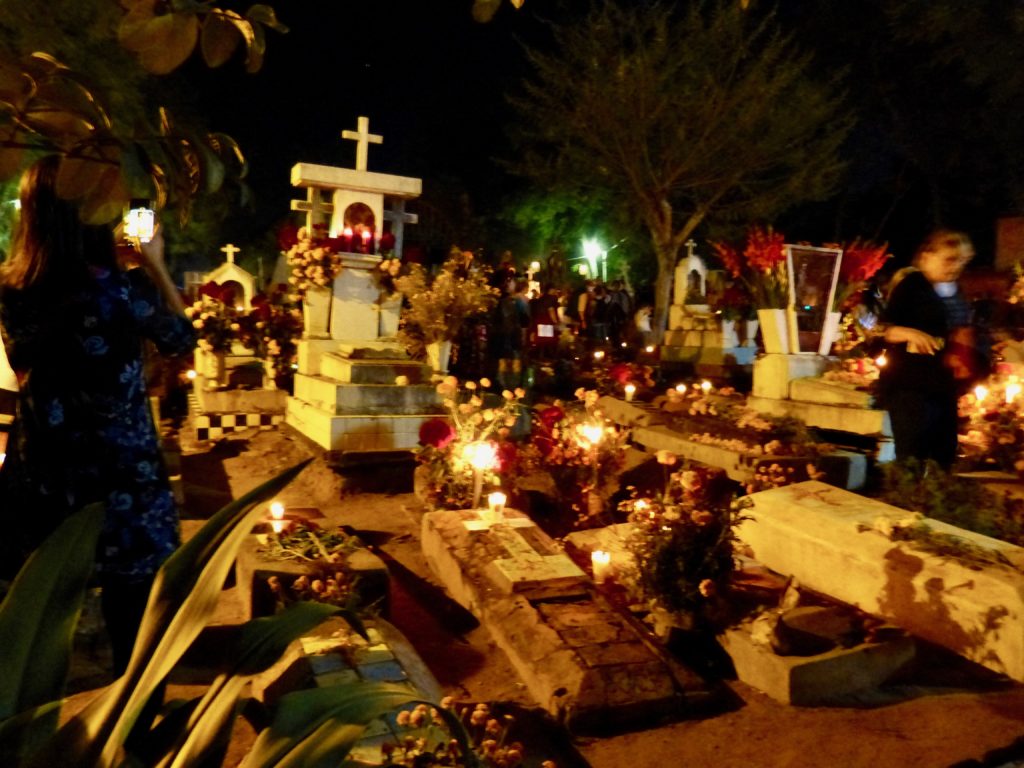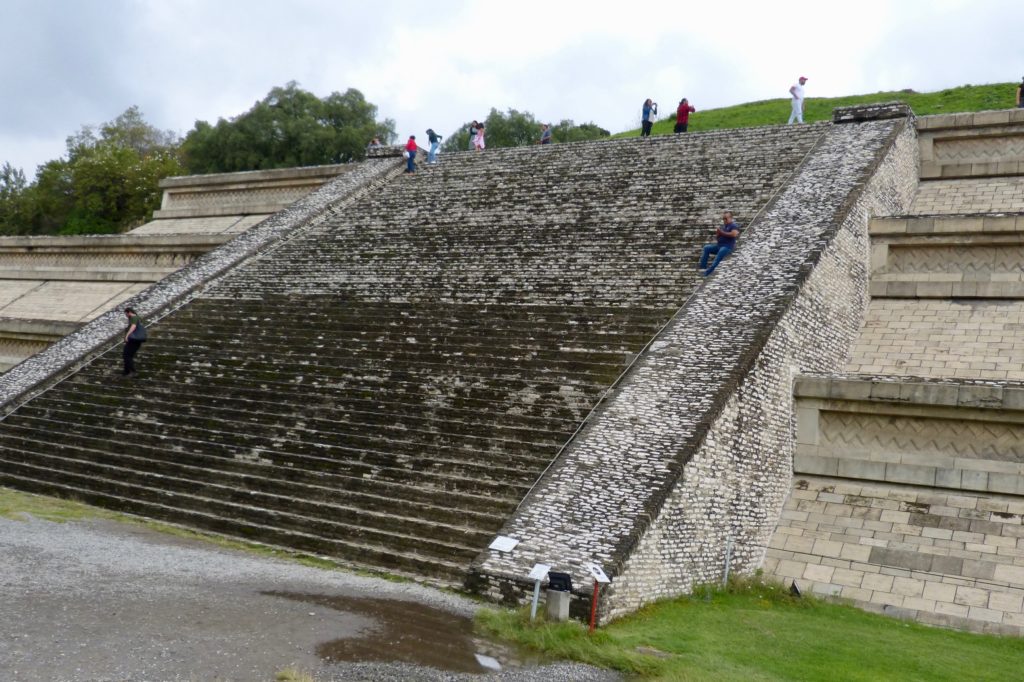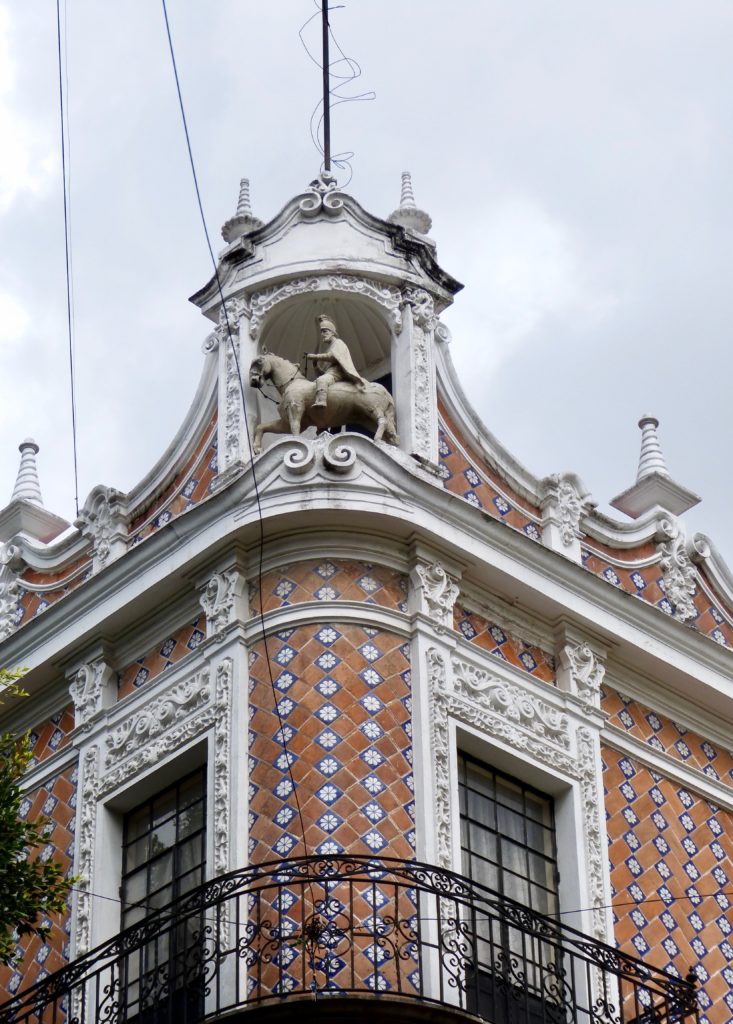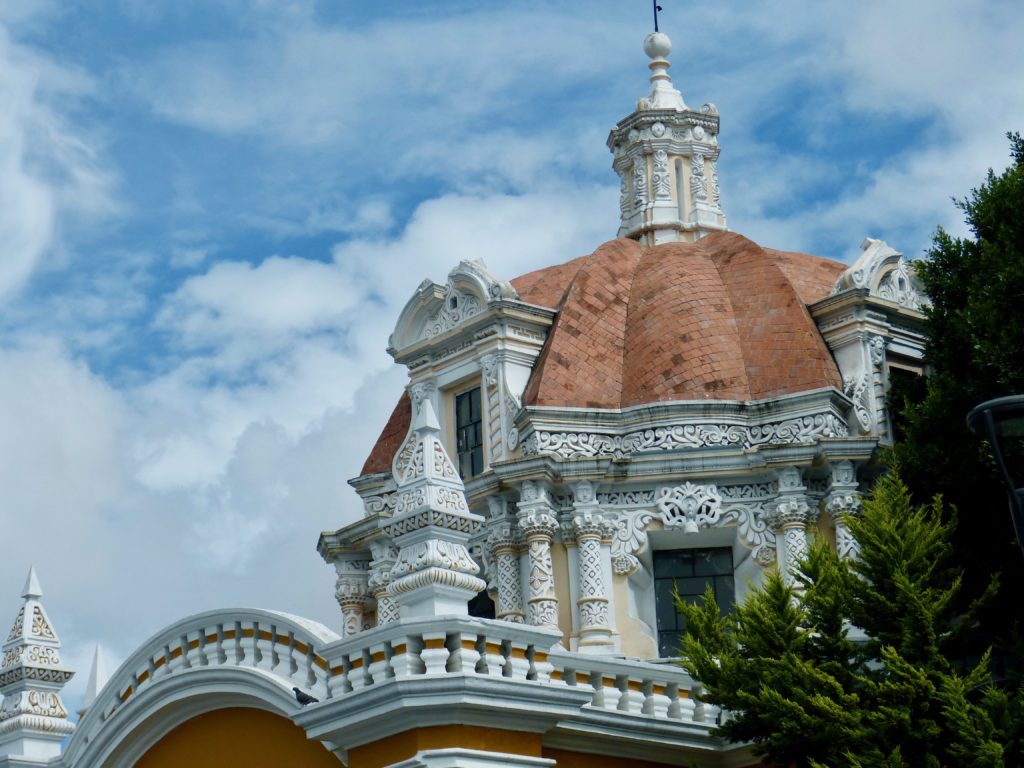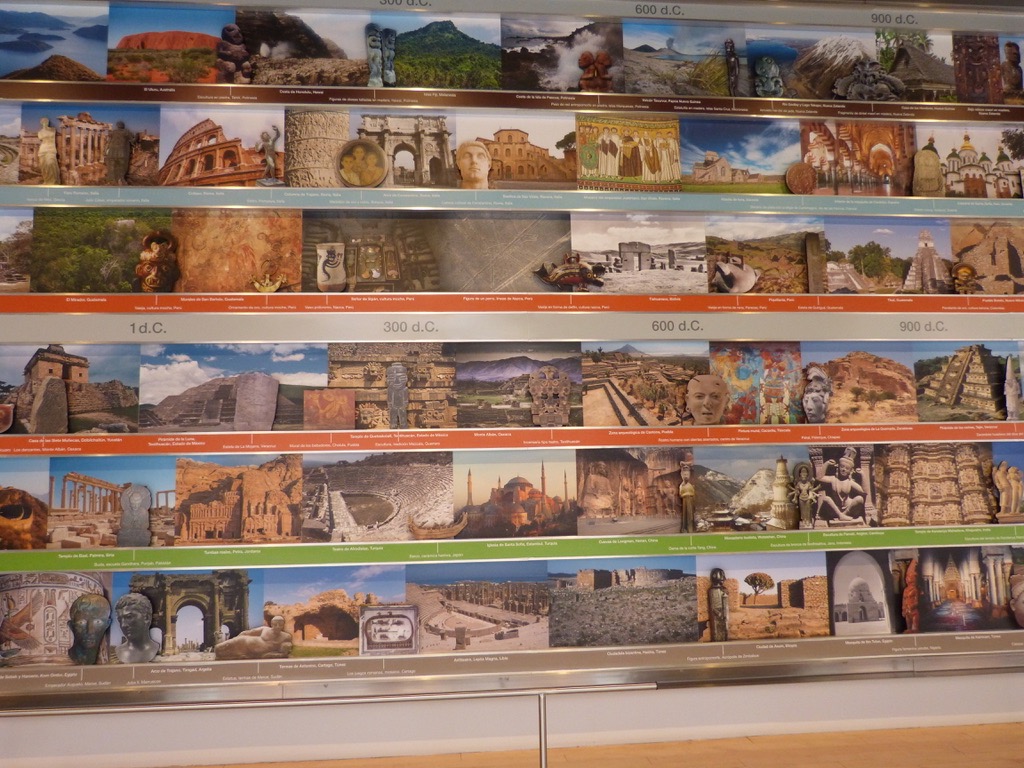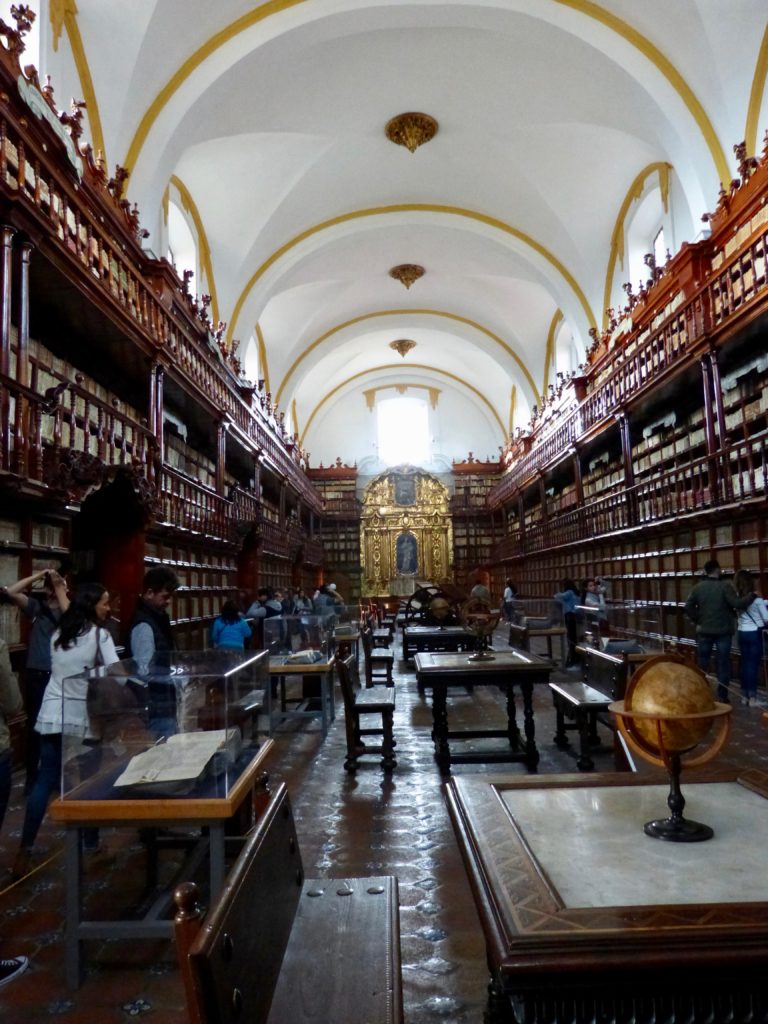Like a lot of people I had visited Mexico’s coasts: the Riviera Maya on the Caribbean side and Acapulco and Puerto Vallarta on the Pacific one. But I had never visited Mexico city, and, more importantly I had never visited au the end of October for the Día de los Muertos. Having read an article in the local paper about all the celebrations surrounding this yearly event, I was curious to experience it first hand. And I was lucky enough to get an invite!!
I flew into Mexico city. My first impression was very good, it does not feel as polluted as it is known to be, and although it is huge and densely populated (21,672,000 at last count) I never felt crowded or overwhelmed.
My first explorations revealed beautiful architecture, a lot of art work, in parks and roundabouts and streets.
My first visit was the National anthropology museum.
The museum is spread around a semi covered patio. An umbrella, supported by a sculpted column covers most of the entrance, while a water feature occupies the rest of the space.
The marble entrance features the national Mexican emblem. The museum covers the prehistoric and pre-Columbian history of Mexico, as well as indigenous Mexican cultures. They have impressive Olmec, Mayan from Teotihiuacan, Nahuas, Toltec and of course Aztec pieces.
Speaking of museums, I also visited a very different but no less interesting one: the Museo Soumaya. It is named after Soumaya Domit, wife of the founder, Carlos Slim. It is a private museum, and free! Yet has over 66,000 pieces from 30 centuries of Mexican art as well as an extensive repertoire of works by European artists such as Rodin, Salvador Dali, Murillo and Tintoretto. The building itself is unique and striking. It was designed by Fernando Romero.
I had booked a cooking class for the following morning. We met at the Medellin market, to check out the local produce and then walked over to the cooking school. Needless to say there was a large variety of peppers, and mole, and hot sauces….
On the way we crossed a lot of flower displays, mostly marigolds ( a sign of things to come) and street vendors…
The class itself was a lot of fun.
The next day I went to visit the Palacio Nacional. This is where you can find the spectacular murals by Diego Rivera (who besides his artistic accomplishments was married to Frida Kahlo). It is breathtaking to see the history of his country (from 1531 to 1930) on the walls over three stories.
One of the widest avenues is Paseo de la Reforma, which runs across the heart of the city. On Sundays it is closed to traffic and reserved for pedestrians and cyclists of all sorts. During part of October and November it is decorated with cartoneria (giant colourful papier-maché fantastic figures) called Alebrijes.
Another of the strongest and most recognizable symbols of the Day of the Dead is the tall female skeleton with a fancy hat with feathers known as La Catrina. She was brought to life in the early 1900’s by artist Guadalupe Posada, a cartoonist who used her to remind people that, no matter the colour of their skin, no matter what society they belonged to, they would all end up skeletons in the end. Diego Rivera also painted several Catrinas over the years and contributed to the look she is well known for today.
The day of the dead is not the “Mexican Halloween”. It is a set of traditions, that can vary slightly depending on the area, but that are all meant to honour de dead.
Anyone who has seen the film Coco will already know this but for the others, here is a brief explanation of what the Día des los Muertos is about: During these days, locals believe that the gap between our world and the spiritual world opens, and they invite their loved ones back for a celebration. This is done with ofrendas, or offerings, placed on altars in homes, schools, and cemeteries.
Altars are decorated with pictures of the deceased, sugar skulls, crosses, candles, papel picado, and flowers. Fruit, nuts, special pan de muertos bread and even beer are also offered – things the departed would have enjoyed in life. Copal incense is burned to purify the air, and trails of yellow marigold and magenta cockscomb flowers help the dead find their way back from the spirit world.
One of the cities that is known for the way it celebrates el Día de los Muertos is Oaxaca, located at the foothills of the Sierra Madre. So that is where I headed next ( a one hour plane ride away from Mexico).
Oaxaca is a lovely city, with the mountains as back drop, and brightly coloured buildings.
Immediately I noticed the flowers strung over the streets. In the streets of Mexico, papel picados ( decorative sheets of tissue paper) are often strung together to create a banner, but here they string marigolds!

Marigolds are used everywhere to decorate.
As mentioned above, another tradition that is observed in private homes, restaurants, hotels, museums…. is the private altars containing the favorite foods and beverages, as well as photos and memorabilia, of the departed. Some are modest, some are spectacular, but all are touching.
Another tradition, very present in Oaxaca is that every neighbourhood has a band, and they parade up and down the streets followed by children and adults, some in full costume.
Approximately 9 km (6 mi) west of Oaxaca, lies Monte Albán, a large pre-Columbian archeological site. The partially excavated civic/ceremonial center of the Monte Albán site is situated atop an artificially leveled ridge. In addition to the monumental core, the site is characterized by several hundred artificial terraces, and a dozen clusters of mounded architecture covering the entire ridgeline and surrounding flanks.
On the way back from this excursion we stopped at the Guerrero Cuilapam monastery. Established in the 1550s in order to evangelize the Mixtec and Japotec populations, it is now a hauntingly beautiful skeleton of what it used to be.
Back in town, one of the iconic buildings of the Oaxaca landscape is the Templo de Santo Domingo de Guzman. As its name implies, the church and monastery were founded by the Domincan order. They were constructed in the baroque ecclesiastical style over a period of 200 years, between the 16th and 18th centuries. The complex includes a substantial sanctuary and an extensive system of courtyards, cloisters and rooms that formerly constituted the monastery.
During the revolutionary wars the buildings were used a barracks. The church was restored to religious use in 1938 and the monastery became a museum in 1972.
The former monastery garden is now an ethnobotanical garden containing a large collection of plants native to the region.
Through the week, parades were going on, make-up artists were painting Catrina faces on everyone, in the evening there was music and dancing in the main square.
But the one night that I had been waiting for the most was October 31st! That is when the families go to the cemetery to clean and adorn their loved one’s tombs and then spend the night amid thousands of candles, praying, and visiting.
Walking in those dark mysterious spaces only lit by candlelight was very unsettling at first. But as you walked though and saw the beautiful flower arrangements and all the work and love put in those displays it was heartwarming.
The was food and drink and even music playing. The feeling, especially outside the gates, was definitely festive.
We visited two cemeteries; the first one was lit by votive candles, the second by very tall ones. The paths between the tombs was so narrow that you could feel the heat of the candles on your legs at times.
This was a definitely once in a lifetime experience!
After a brief return in Mexico city, we headed south east (by bus) to the colonial city of Puebla.
There is a lot to see in Puebla, but we started with the archeological site of San Pedro de Cholula. The Great Pyramid was an important religious and mythical centre in prehispanic times. Over a period of a thousand years prior to the Spanish Conquest, consecutive construction phases gradually built up the bulk of the pyramid until it became the largest in Mexico by volume.
The San Gabriel monastery stands over the site. Excavations have resulted in about eight kilometers of tunnels inside the pyramid; we entered on the north side, through the center of the pyramid and exited on the south side of the site. It is a large site, only partly excavated. We came across an odd looking animal part squirrel, part ground hog, with unusual markings and a bumby tail…
Leaving the site we walked around the city, and came across some very pretty buildings.
We stopped at Museo Amparo which has an impressive Pre-Columbian Art collection in a beautiful modern setting. It also had a mural depicting the evolution of the human species on earth which I found fascinating.
Our next stop was the Palafoxiana librairy. This spectacular collection started in 1646, when the bishop of Puebla, Juan de Palafox y Mendoza, donated a rich and select personal library of 5,000 volumes. The donations continued through the years and today, some 45,059 volumes dating from the 15th, 16th, 17th, 18th, 19th centuries coexist with a few from the 20th century. By 1773, then Bishop of Puebla, Francisco Fabián y Fuero, established the principal nave of the Palafoxiana Library at 43 meters, he also had two floors of fine shelves built in fine ayacahuite, coloyote and cedar.
On the way out we crossed paths with a Catrina.
Our next stop was the Church of Santo Domingo de Guzmán and its Chapel of the Rosario, an example of the New Spanish Baroque, considered in its time to be the” eighth wonder of the world”. (Lots of gold!)
Puebla is a very colourful city
Puebla is also f was well known for its fine ceramics, especially for the style that would be called Talavera.
The church of San Cristobal is a landmark day and night….

This was a memorable trip. I have not mentioned food and drink but they are both worth mentioning. I got to savour all the traditional dishes as well as more adventurous avant garde ones and all were wonderful.
As for drink, my big discovery was Mezcal (not to be confused with mescaline). It is a distilled alcoholic beverage made from agave (like tequila) and is the national spirit of Mexico. The word mezcal comes from Nahuatl mexcalli which means “oven-cooked agave”. It has a strong smoky flavor, and although Mexicans usually consume it straight, I also go to have it in great cocktails, both sweet ( the Paloma with grapefruit juice) and savoury (with hot pepper juice).

